Business Law: Understanding the Legal System and its Impact on Businesses
VerifiedAdded on 2024/06/04
|22
|4514
|164
AI Summary
This handbook provides a comprehensive overview of the UK legal system, focusing on its impact on businesses. It explores different sources of law, the role of government in law-making, and key legislations affecting companies, employment, and contracts. The handbook also suggests legal solutions for common business problems, including contract termination and insolvency, and compares traditional litigation with alternative dispute resolution methods.
Contribute Materials
Your contribution can guide someone’s learning journey. Share your
documents today.
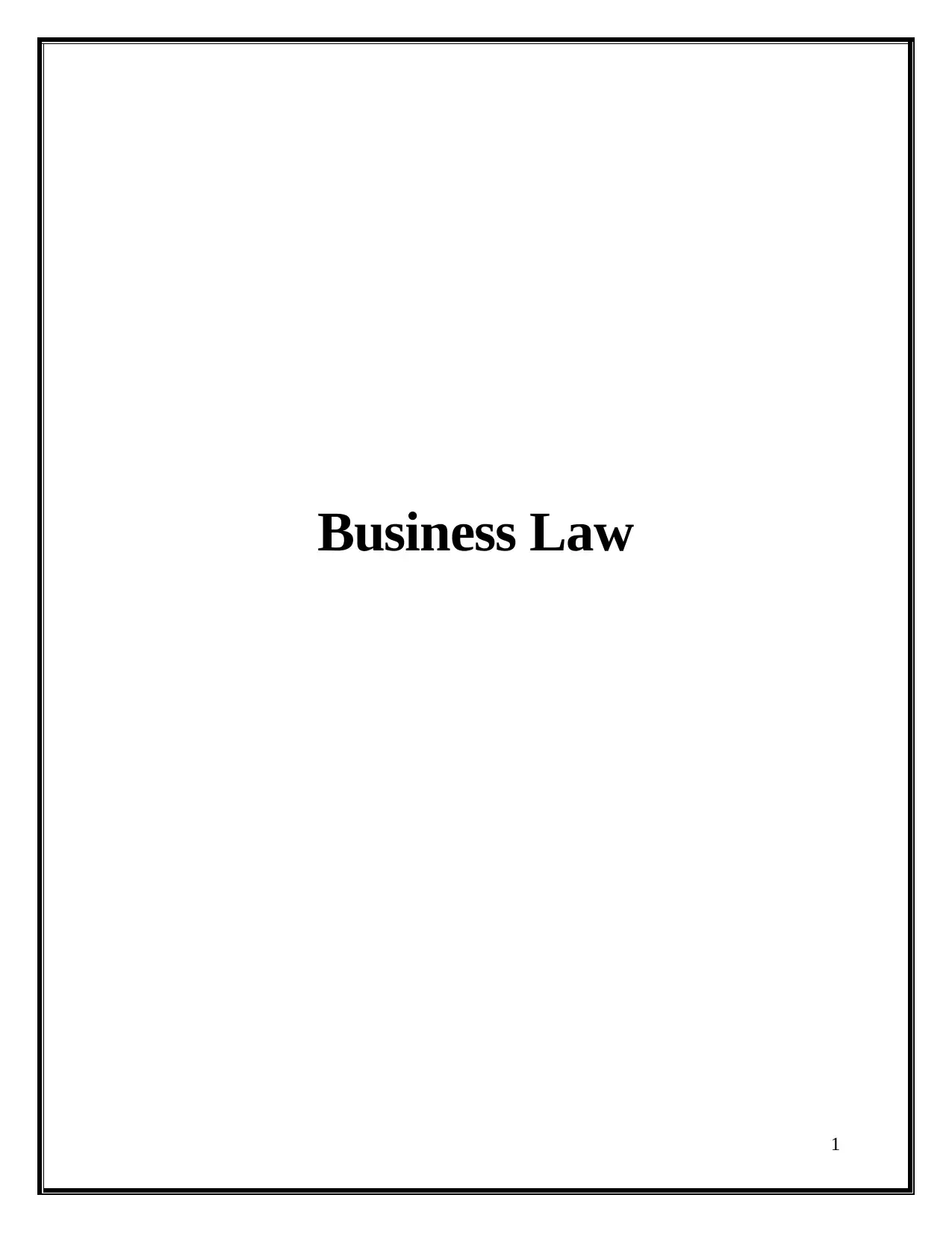
Business Law
1
1
Secure Best Marks with AI Grader
Need help grading? Try our AI Grader for instant feedback on your assignments.
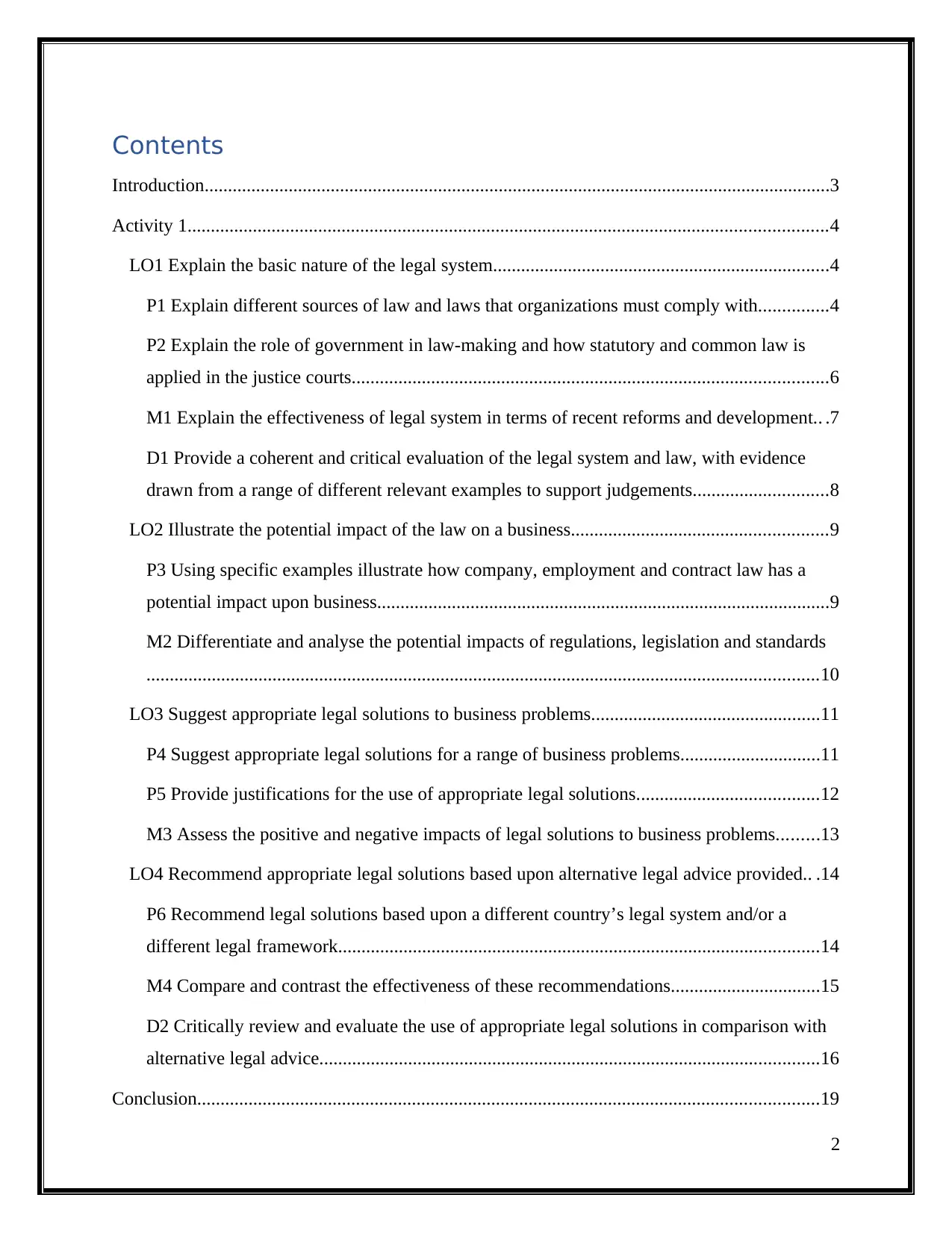
Contents
Introduction......................................................................................................................................3
Activity 1.........................................................................................................................................4
LO1 Explain the basic nature of the legal system........................................................................4
P1 Explain different sources of law and laws that organizations must comply with...............4
P2 Explain the role of government in law-making and how statutory and common law is
applied in the justice courts......................................................................................................6
M1 Explain the effectiveness of legal system in terms of recent reforms and development.. .7
D1 Provide a coherent and critical evaluation of the legal system and law, with evidence
drawn from a range of different relevant examples to support judgements.............................8
LO2 Illustrate the potential impact of the law on a business.......................................................9
P3 Using specific examples illustrate how company, employment and contract law has a
potential impact upon business.................................................................................................9
M2 Differentiate and analyse the potential impacts of regulations, legislation and standards
................................................................................................................................................10
LO3 Suggest appropriate legal solutions to business problems.................................................11
P4 Suggest appropriate legal solutions for a range of business problems..............................11
P5 Provide justifications for the use of appropriate legal solutions.......................................12
M3 Assess the positive and negative impacts of legal solutions to business problems.........13
LO4 Recommend appropriate legal solutions based upon alternative legal advice provided.. .14
P6 Recommend legal solutions based upon a different country’s legal system and/or a
different legal framework.......................................................................................................14
M4 Compare and contrast the effectiveness of these recommendations................................15
D2 Critically review and evaluate the use of appropriate legal solutions in comparison with
alternative legal advice...........................................................................................................16
Conclusion.....................................................................................................................................19
2
Introduction......................................................................................................................................3
Activity 1.........................................................................................................................................4
LO1 Explain the basic nature of the legal system........................................................................4
P1 Explain different sources of law and laws that organizations must comply with...............4
P2 Explain the role of government in law-making and how statutory and common law is
applied in the justice courts......................................................................................................6
M1 Explain the effectiveness of legal system in terms of recent reforms and development.. .7
D1 Provide a coherent and critical evaluation of the legal system and law, with evidence
drawn from a range of different relevant examples to support judgements.............................8
LO2 Illustrate the potential impact of the law on a business.......................................................9
P3 Using specific examples illustrate how company, employment and contract law has a
potential impact upon business.................................................................................................9
M2 Differentiate and analyse the potential impacts of regulations, legislation and standards
................................................................................................................................................10
LO3 Suggest appropriate legal solutions to business problems.................................................11
P4 Suggest appropriate legal solutions for a range of business problems..............................11
P5 Provide justifications for the use of appropriate legal solutions.......................................12
M3 Assess the positive and negative impacts of legal solutions to business problems.........13
LO4 Recommend appropriate legal solutions based upon alternative legal advice provided.. .14
P6 Recommend legal solutions based upon a different country’s legal system and/or a
different legal framework.......................................................................................................14
M4 Compare and contrast the effectiveness of these recommendations................................15
D2 Critically review and evaluate the use of appropriate legal solutions in comparison with
alternative legal advice...........................................................................................................16
Conclusion.....................................................................................................................................19
2

References......................................................................................................................................20
3
3
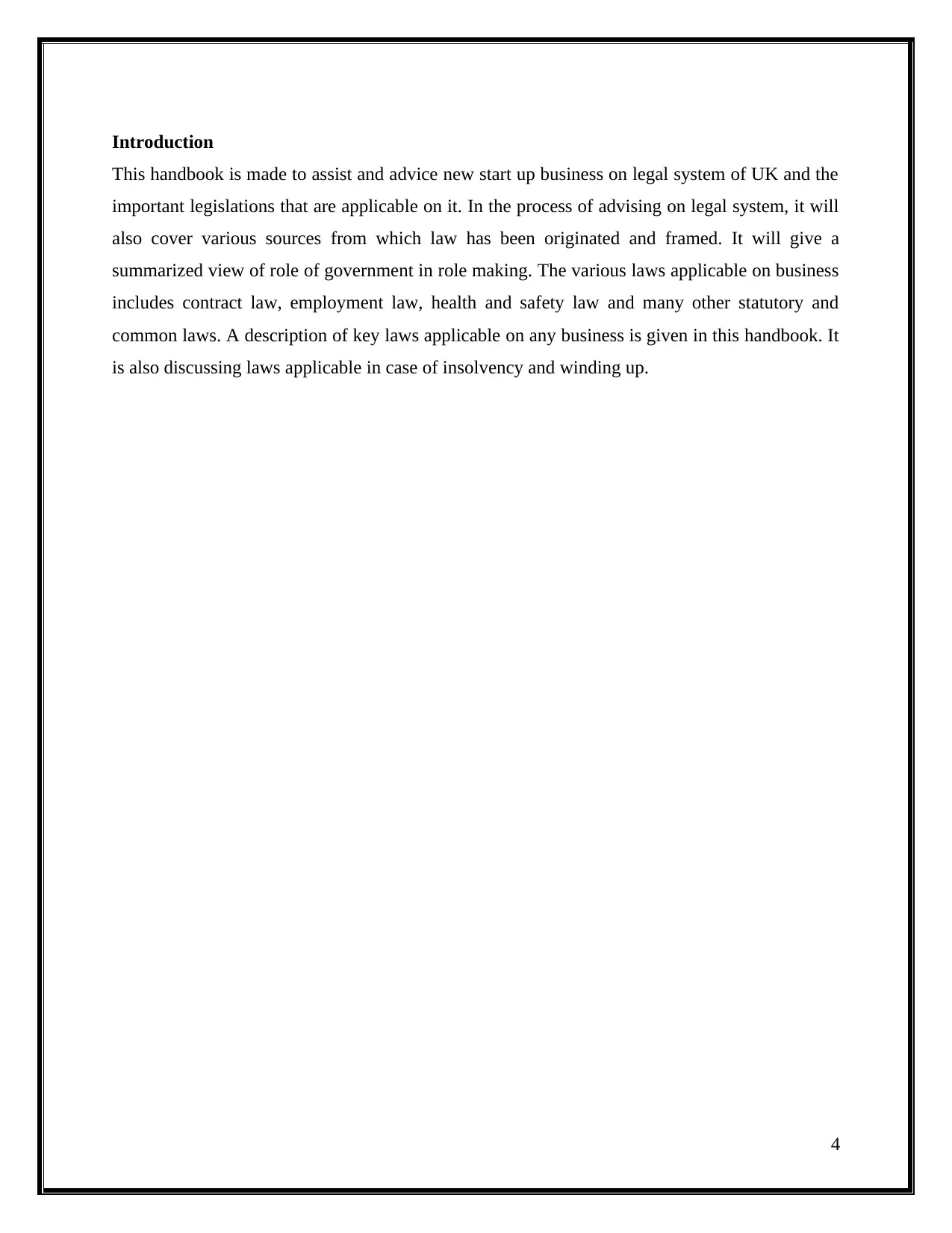
Introduction
This handbook is made to assist and advice new start up business on legal system of UK and the
important legislations that are applicable on it. In the process of advising on legal system, it will
also cover various sources from which law has been originated and framed. It will give a
summarized view of role of government in role making. The various laws applicable on business
includes contract law, employment law, health and safety law and many other statutory and
common laws. A description of key laws applicable on any business is given in this handbook. It
is also discussing laws applicable in case of insolvency and winding up.
4
This handbook is made to assist and advice new start up business on legal system of UK and the
important legislations that are applicable on it. In the process of advising on legal system, it will
also cover various sources from which law has been originated and framed. It will give a
summarized view of role of government in role making. The various laws applicable on business
includes contract law, employment law, health and safety law and many other statutory and
common laws. A description of key laws applicable on any business is given in this handbook. It
is also discussing laws applicable in case of insolvency and winding up.
4
Secure Best Marks with AI Grader
Need help grading? Try our AI Grader for instant feedback on your assignments.
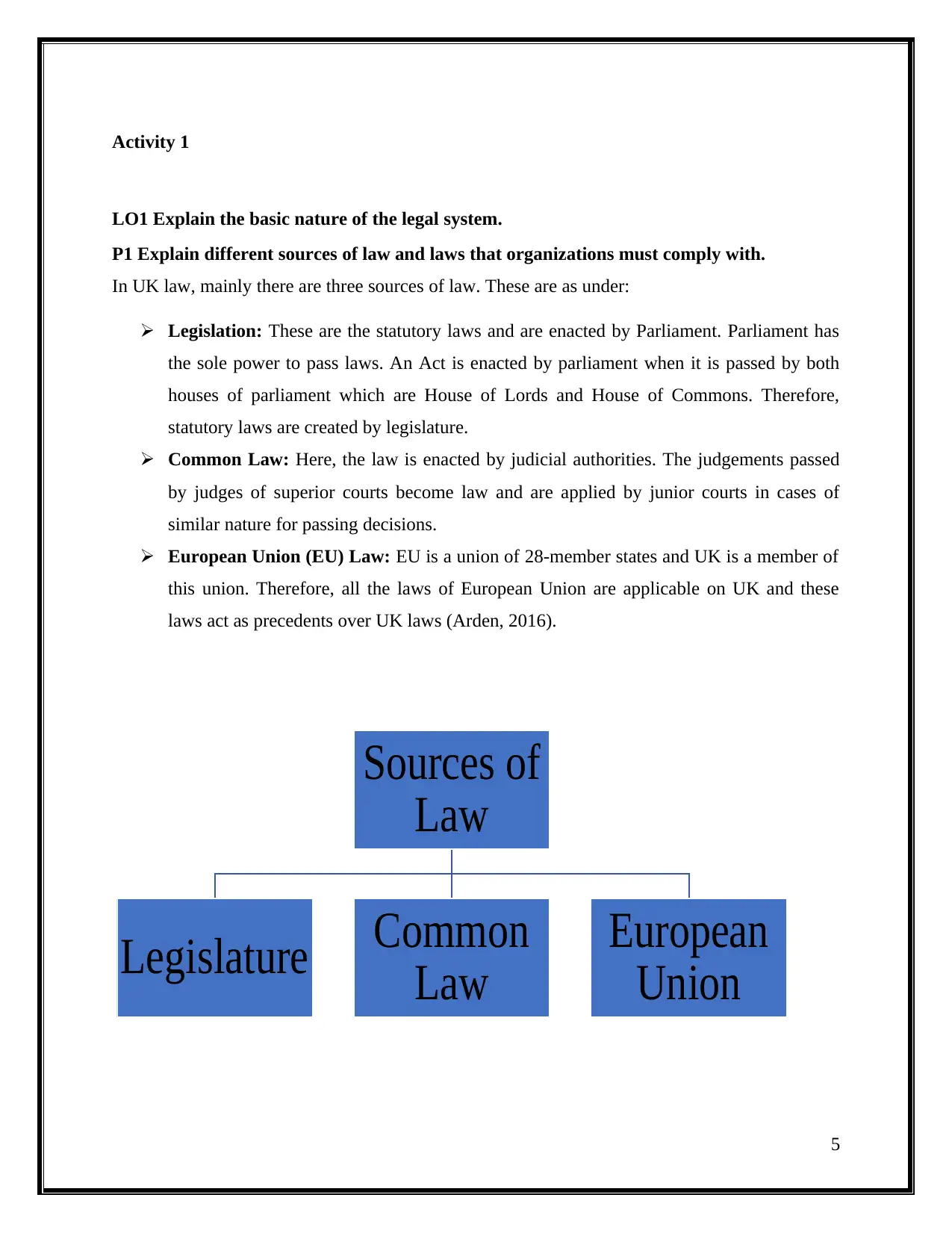
Activity 1
LO1 Explain the basic nature of the legal system.
P1 Explain different sources of law and laws that organizations must comply with.
In UK law, mainly there are three sources of law. These are as under:
Legislation: These are the statutory laws and are enacted by Parliament. Parliament has
the sole power to pass laws. An Act is enacted by parliament when it is passed by both
houses of parliament which are House of Lords and House of Commons. Therefore,
statutory laws are created by legislature.
Common Law: Here, the law is enacted by judicial authorities. The judgements passed
by judges of superior courts become law and are applied by junior courts in cases of
similar nature for passing decisions.
European Union (EU) Law: EU is a union of 28-member states and UK is a member of
this union. Therefore, all the laws of European Union are applicable on UK and these
laws act as precedents over UK laws (Arden, 2016).
5
Sources of
Law
Legislature Common
Law
European
Union
LO1 Explain the basic nature of the legal system.
P1 Explain different sources of law and laws that organizations must comply with.
In UK law, mainly there are three sources of law. These are as under:
Legislation: These are the statutory laws and are enacted by Parliament. Parliament has
the sole power to pass laws. An Act is enacted by parliament when it is passed by both
houses of parliament which are House of Lords and House of Commons. Therefore,
statutory laws are created by legislature.
Common Law: Here, the law is enacted by judicial authorities. The judgements passed
by judges of superior courts become law and are applied by junior courts in cases of
similar nature for passing decisions.
European Union (EU) Law: EU is a union of 28-member states and UK is a member of
this union. Therefore, all the laws of European Union are applicable on UK and these
laws act as precedents over UK laws (Arden, 2016).
5
Sources of
Law
Legislature Common
Law
European
Union
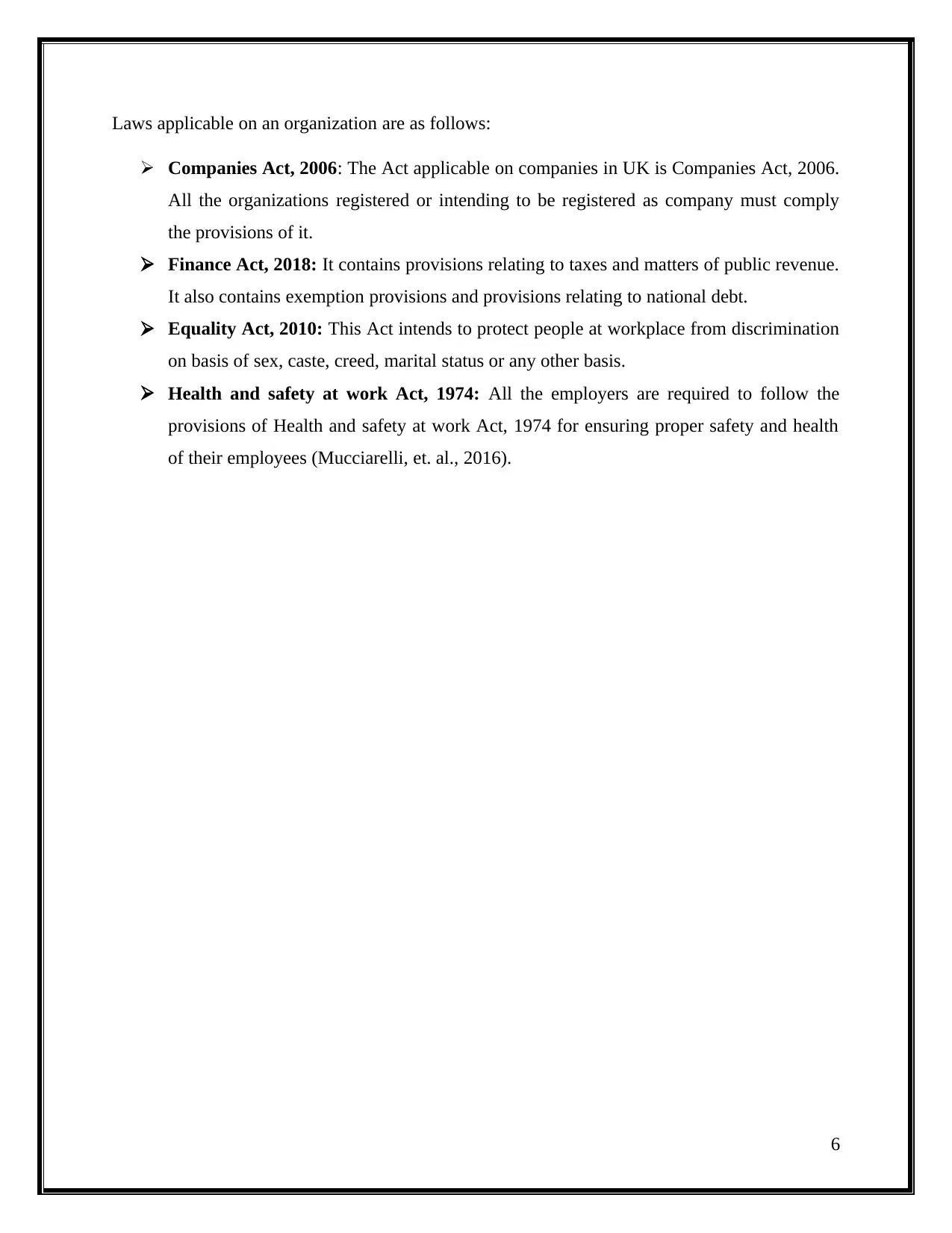
Laws applicable on an organization are as follows:
Companies Act, 2006: The Act applicable on companies in UK is Companies Act, 2006.
All the organizations registered or intending to be registered as company must comply
the provisions of it.
Finance Act, 2018: It contains provisions relating to taxes and matters of public revenue.
It also contains exemption provisions and provisions relating to national debt.
Equality Act, 2010: This Act intends to protect people at workplace from discrimination
on basis of sex, caste, creed, marital status or any other basis.
Health and safety at work Act, 1974: All the employers are required to follow the
provisions of Health and safety at work Act, 1974 for ensuring proper safety and health
of their employees (Mucciarelli, et. al., 2016).
6
Companies Act, 2006: The Act applicable on companies in UK is Companies Act, 2006.
All the organizations registered or intending to be registered as company must comply
the provisions of it.
Finance Act, 2018: It contains provisions relating to taxes and matters of public revenue.
It also contains exemption provisions and provisions relating to national debt.
Equality Act, 2010: This Act intends to protect people at workplace from discrimination
on basis of sex, caste, creed, marital status or any other basis.
Health and safety at work Act, 1974: All the employers are required to follow the
provisions of Health and safety at work Act, 1974 for ensuring proper safety and health
of their employees (Mucciarelli, et. al., 2016).
6
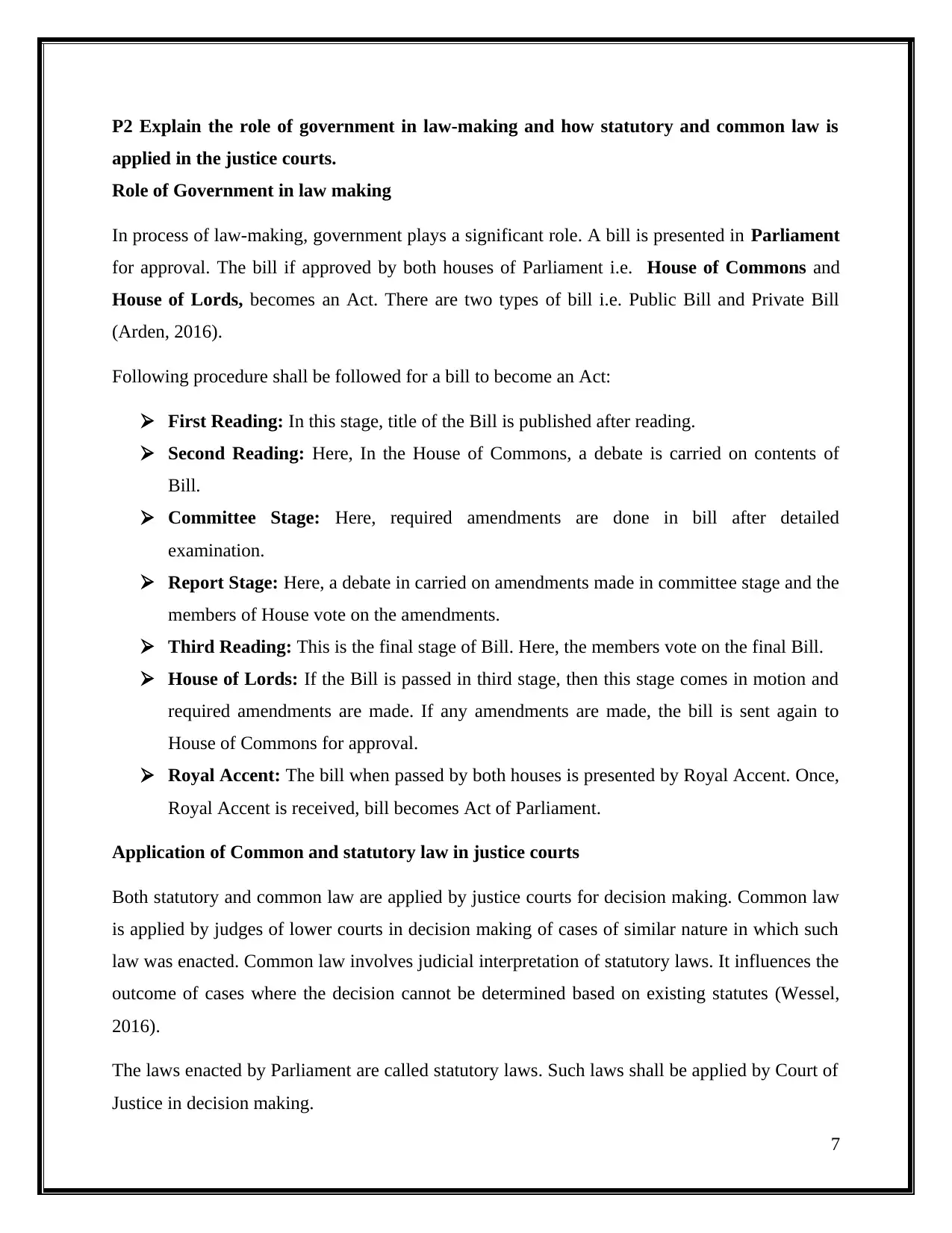
P2 Explain the role of government in law-making and how statutory and common law is
applied in the justice courts.
Role of Government in law making
In process of law-making, government plays a significant role. A bill is presented in Parliament
for approval. The bill if approved by both houses of Parliament i.e. House of Commons and
House of Lords, becomes an Act. There are two types of bill i.e. Public Bill and Private Bill
(Arden, 2016).
Following procedure shall be followed for a bill to become an Act:
First Reading: In this stage, title of the Bill is published after reading.
Second Reading: Here, In the House of Commons, a debate is carried on contents of
Bill.
Committee Stage: Here, required amendments are done in bill after detailed
examination.
Report Stage: Here, a debate in carried on amendments made in committee stage and the
members of House vote on the amendments.
Third Reading: This is the final stage of Bill. Here, the members vote on the final Bill.
House of Lords: If the Bill is passed in third stage, then this stage comes in motion and
required amendments are made. If any amendments are made, the bill is sent again to
House of Commons for approval.
Royal Accent: The bill when passed by both houses is presented by Royal Accent. Once,
Royal Accent is received, bill becomes Act of Parliament.
Application of Common and statutory law in justice courts
Both statutory and common law are applied by justice courts for decision making. Common law
is applied by judges of lower courts in decision making of cases of similar nature in which such
law was enacted. Common law involves judicial interpretation of statutory laws. It influences the
outcome of cases where the decision cannot be determined based on existing statutes (Wessel,
2016).
The laws enacted by Parliament are called statutory laws. Such laws shall be applied by Court of
Justice in decision making.
7
applied in the justice courts.
Role of Government in law making
In process of law-making, government plays a significant role. A bill is presented in Parliament
for approval. The bill if approved by both houses of Parliament i.e. House of Commons and
House of Lords, becomes an Act. There are two types of bill i.e. Public Bill and Private Bill
(Arden, 2016).
Following procedure shall be followed for a bill to become an Act:
First Reading: In this stage, title of the Bill is published after reading.
Second Reading: Here, In the House of Commons, a debate is carried on contents of
Bill.
Committee Stage: Here, required amendments are done in bill after detailed
examination.
Report Stage: Here, a debate in carried on amendments made in committee stage and the
members of House vote on the amendments.
Third Reading: This is the final stage of Bill. Here, the members vote on the final Bill.
House of Lords: If the Bill is passed in third stage, then this stage comes in motion and
required amendments are made. If any amendments are made, the bill is sent again to
House of Commons for approval.
Royal Accent: The bill when passed by both houses is presented by Royal Accent. Once,
Royal Accent is received, bill becomes Act of Parliament.
Application of Common and statutory law in justice courts
Both statutory and common law are applied by justice courts for decision making. Common law
is applied by judges of lower courts in decision making of cases of similar nature in which such
law was enacted. Common law involves judicial interpretation of statutory laws. It influences the
outcome of cases where the decision cannot be determined based on existing statutes (Wessel,
2016).
The laws enacted by Parliament are called statutory laws. Such laws shall be applied by Court of
Justice in decision making.
7
Paraphrase This Document
Need a fresh take? Get an instant paraphrase of this document with our AI Paraphraser
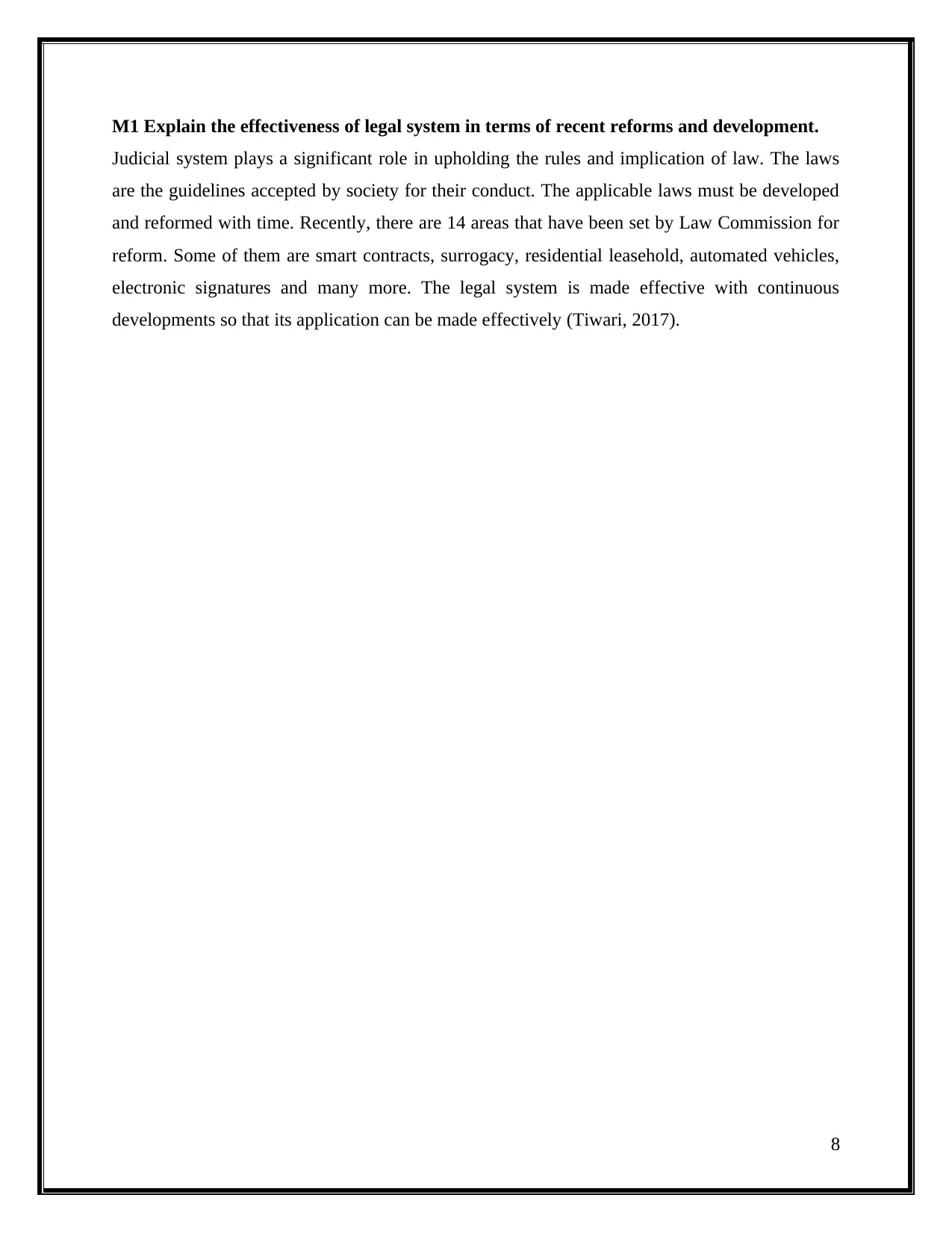
M1 Explain the effectiveness of legal system in terms of recent reforms and development.
Judicial system plays a significant role in upholding the rules and implication of law. The laws
are the guidelines accepted by society for their conduct. The applicable laws must be developed
and reformed with time. Recently, there are 14 areas that have been set by Law Commission for
reform. Some of them are smart contracts, surrogacy, residential leasehold, automated vehicles,
electronic signatures and many more. The legal system is made effective with continuous
developments so that its application can be made effectively (Tiwari, 2017).
8
Judicial system plays a significant role in upholding the rules and implication of law. The laws
are the guidelines accepted by society for their conduct. The applicable laws must be developed
and reformed with time. Recently, there are 14 areas that have been set by Law Commission for
reform. Some of them are smart contracts, surrogacy, residential leasehold, automated vehicles,
electronic signatures and many more. The legal system is made effective with continuous
developments so that its application can be made effectively (Tiwari, 2017).
8
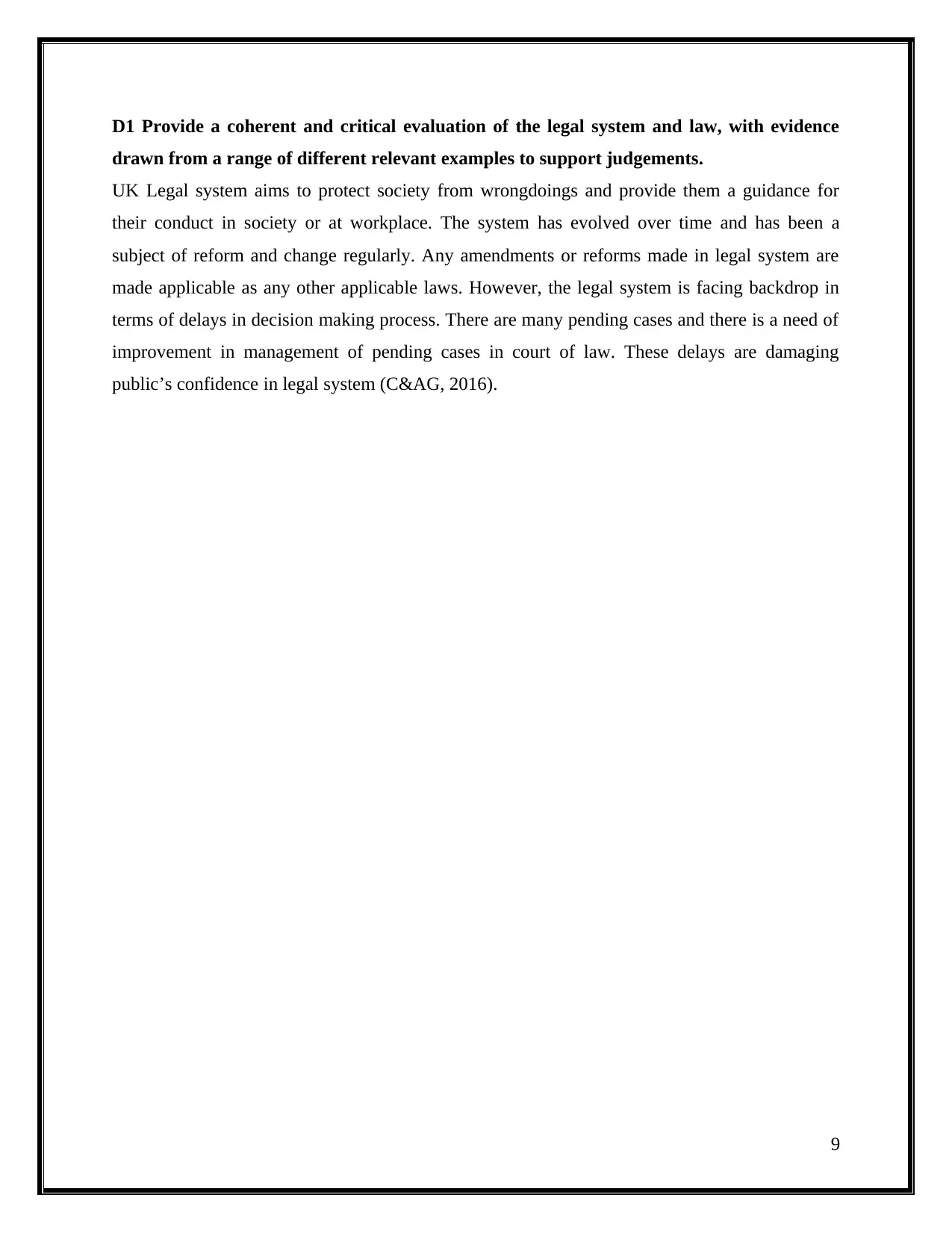
D1 Provide a coherent and critical evaluation of the legal system and law, with evidence
drawn from a range of different relevant examples to support judgements.
UK Legal system aims to protect society from wrongdoings and provide them a guidance for
their conduct in society or at workplace. The system has evolved over time and has been a
subject of reform and change regularly. Any amendments or reforms made in legal system are
made applicable as any other applicable laws. However, the legal system is facing backdrop in
terms of delays in decision making process. There are many pending cases and there is a need of
improvement in management of pending cases in court of law. These delays are damaging
public’s confidence in legal system (C&AG, 2016).
9
drawn from a range of different relevant examples to support judgements.
UK Legal system aims to protect society from wrongdoings and provide them a guidance for
their conduct in society or at workplace. The system has evolved over time and has been a
subject of reform and change regularly. Any amendments or reforms made in legal system are
made applicable as any other applicable laws. However, the legal system is facing backdrop in
terms of delays in decision making process. There are many pending cases and there is a need of
improvement in management of pending cases in court of law. These delays are damaging
public’s confidence in legal system (C&AG, 2016).
9
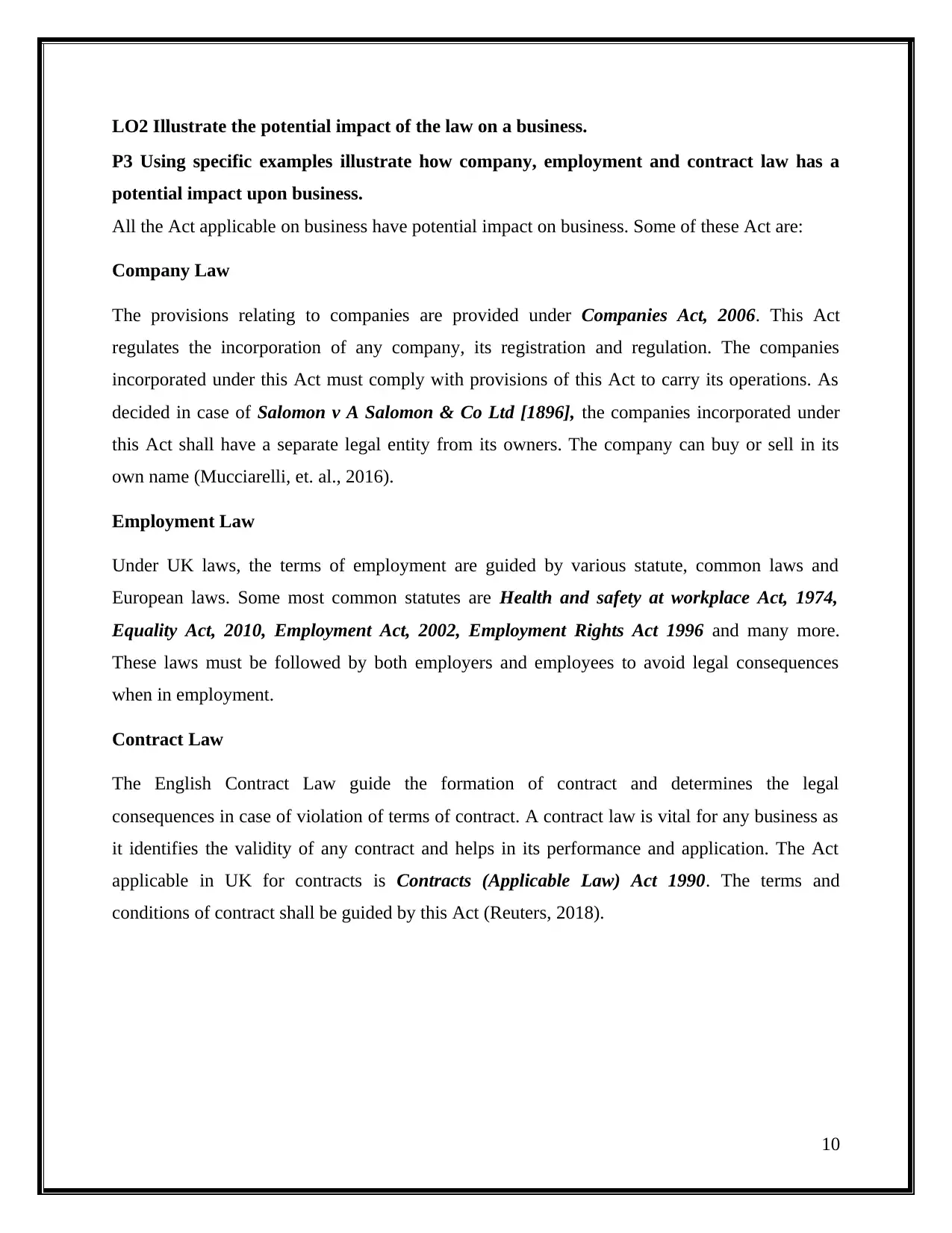
LO2 Illustrate the potential impact of the law on a business.
P3 Using specific examples illustrate how company, employment and contract law has a
potential impact upon business.
All the Act applicable on business have potential impact on business. Some of these Act are:
Company Law
The provisions relating to companies are provided under Companies Act, 2006. This Act
regulates the incorporation of any company, its registration and regulation. The companies
incorporated under this Act must comply with provisions of this Act to carry its operations. As
decided in case of Salomon v A Salomon & Co Ltd [1896], the companies incorporated under
this Act shall have a separate legal entity from its owners. The company can buy or sell in its
own name (Mucciarelli, et. al., 2016).
Employment Law
Under UK laws, the terms of employment are guided by various statute, common laws and
European laws. Some most common statutes are Health and safety at workplace Act, 1974,
Equality Act, 2010, Employment Act, 2002, Employment Rights Act 1996 and many more.
These laws must be followed by both employers and employees to avoid legal consequences
when in employment.
Contract Law
The English Contract Law guide the formation of contract and determines the legal
consequences in case of violation of terms of contract. A contract law is vital for any business as
it identifies the validity of any contract and helps in its performance and application. The Act
applicable in UK for contracts is Contracts (Applicable Law) Act 1990. The terms and
conditions of contract shall be guided by this Act (Reuters, 2018).
10
P3 Using specific examples illustrate how company, employment and contract law has a
potential impact upon business.
All the Act applicable on business have potential impact on business. Some of these Act are:
Company Law
The provisions relating to companies are provided under Companies Act, 2006. This Act
regulates the incorporation of any company, its registration and regulation. The companies
incorporated under this Act must comply with provisions of this Act to carry its operations. As
decided in case of Salomon v A Salomon & Co Ltd [1896], the companies incorporated under
this Act shall have a separate legal entity from its owners. The company can buy or sell in its
own name (Mucciarelli, et. al., 2016).
Employment Law
Under UK laws, the terms of employment are guided by various statute, common laws and
European laws. Some most common statutes are Health and safety at workplace Act, 1974,
Equality Act, 2010, Employment Act, 2002, Employment Rights Act 1996 and many more.
These laws must be followed by both employers and employees to avoid legal consequences
when in employment.
Contract Law
The English Contract Law guide the formation of contract and determines the legal
consequences in case of violation of terms of contract. A contract law is vital for any business as
it identifies the validity of any contract and helps in its performance and application. The Act
applicable in UK for contracts is Contracts (Applicable Law) Act 1990. The terms and
conditions of contract shall be guided by this Act (Reuters, 2018).
10
Secure Best Marks with AI Grader
Need help grading? Try our AI Grader for instant feedback on your assignments.
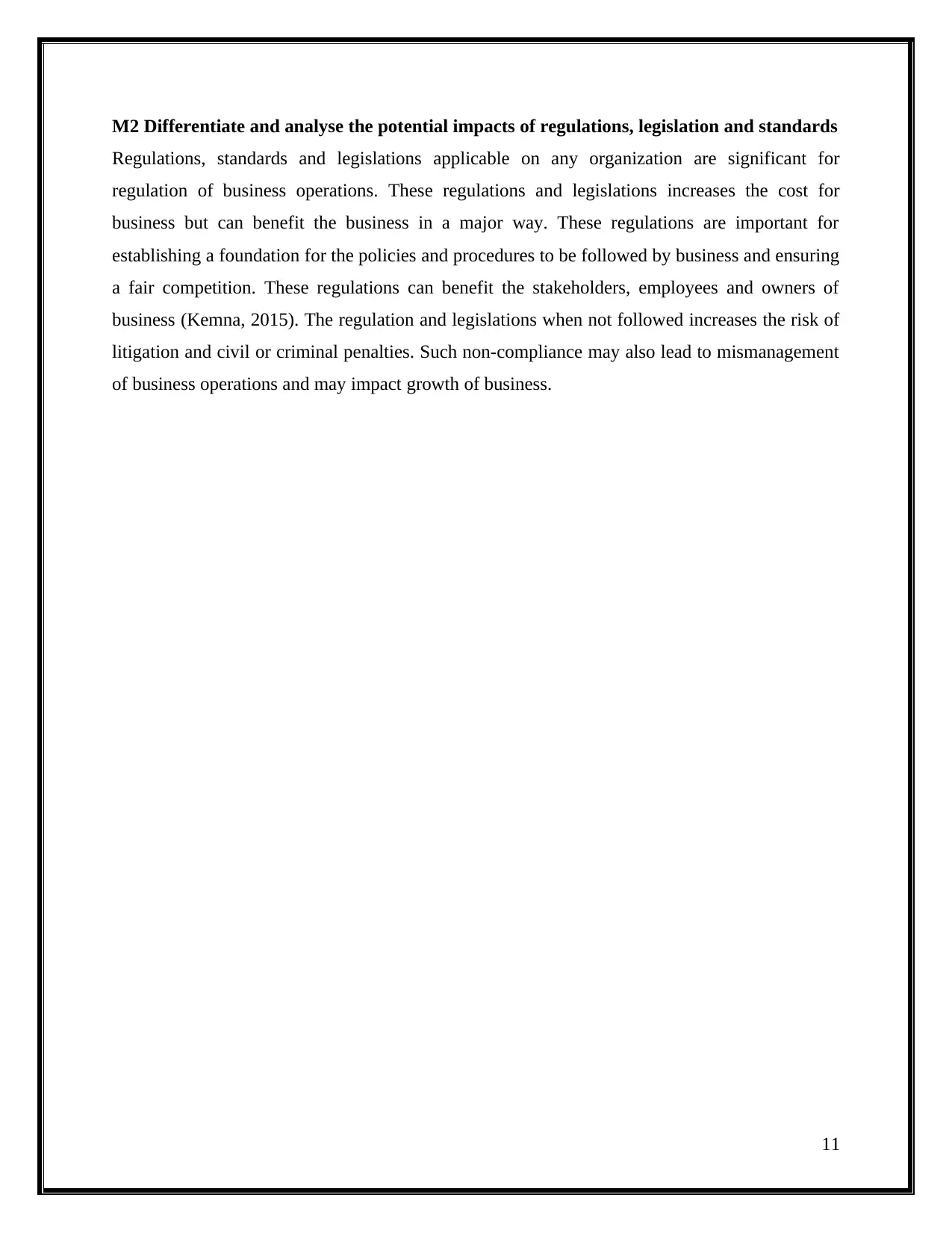
M2 Differentiate and analyse the potential impacts of regulations, legislation and standards
Regulations, standards and legislations applicable on any organization are significant for
regulation of business operations. These regulations and legislations increases the cost for
business but can benefit the business in a major way. These regulations are important for
establishing a foundation for the policies and procedures to be followed by business and ensuring
a fair competition. These regulations can benefit the stakeholders, employees and owners of
business (Kemna, 2015). The regulation and legislations when not followed increases the risk of
litigation and civil or criminal penalties. Such non-compliance may also lead to mismanagement
of business operations and may impact growth of business.
11
Regulations, standards and legislations applicable on any organization are significant for
regulation of business operations. These regulations and legislations increases the cost for
business but can benefit the business in a major way. These regulations are important for
establishing a foundation for the policies and procedures to be followed by business and ensuring
a fair competition. These regulations can benefit the stakeholders, employees and owners of
business (Kemna, 2015). The regulation and legislations when not followed increases the risk of
litigation and civil or criminal penalties. Such non-compliance may also lead to mismanagement
of business operations and may impact growth of business.
11
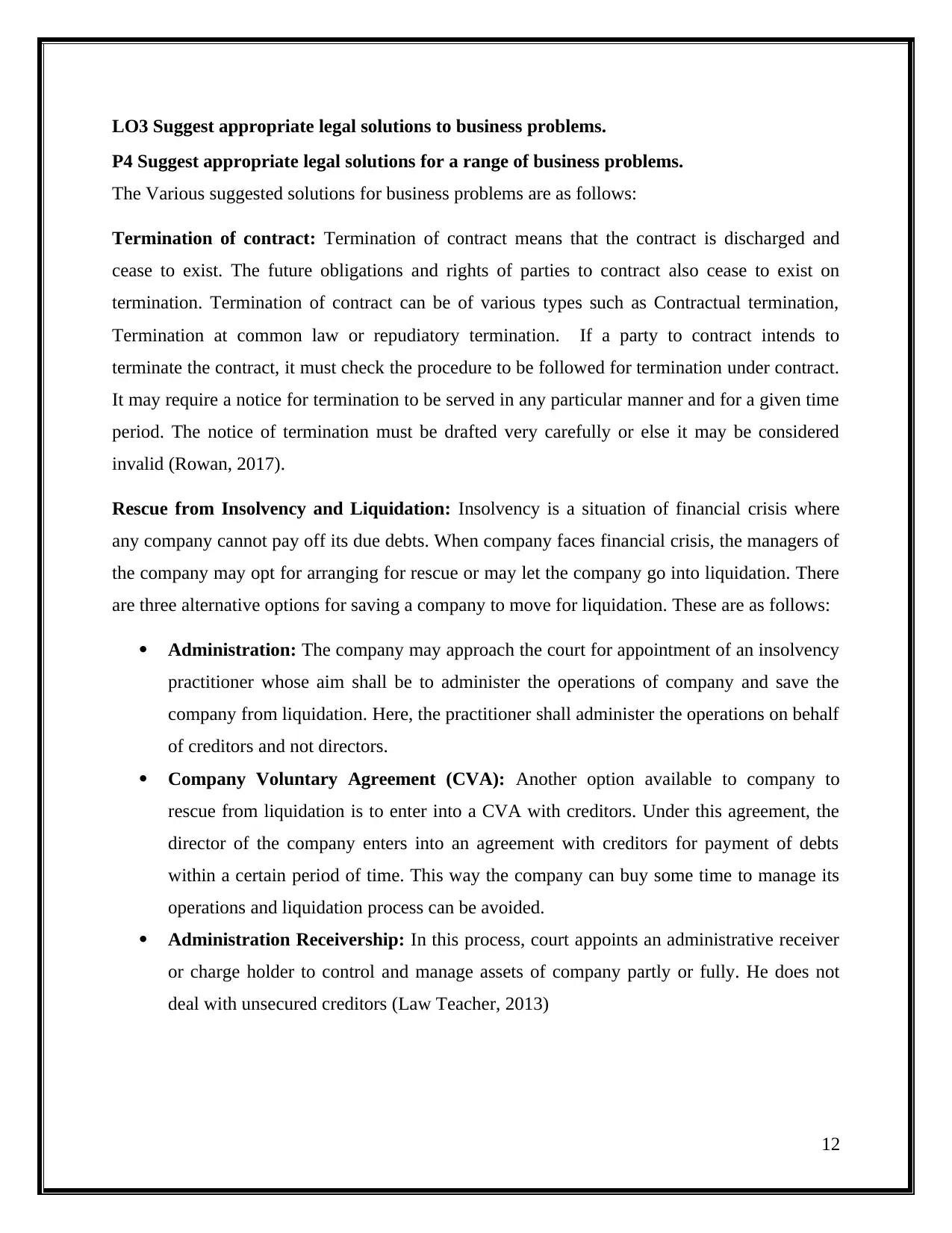
LO3 Suggest appropriate legal solutions to business problems.
P4 Suggest appropriate legal solutions for a range of business problems.
The Various suggested solutions for business problems are as follows:
Termination of contract: Termination of contract means that the contract is discharged and
cease to exist. The future obligations and rights of parties to contract also cease to exist on
termination. Termination of contract can be of various types such as Contractual termination,
Termination at common law or repudiatory termination. If a party to contract intends to
terminate the contract, it must check the procedure to be followed for termination under contract.
It may require a notice for termination to be served in any particular manner and for a given time
period. The notice of termination must be drafted very carefully or else it may be considered
invalid (Rowan, 2017).
Rescue from Insolvency and Liquidation: Insolvency is a situation of financial crisis where
any company cannot pay off its due debts. When company faces financial crisis, the managers of
the company may opt for arranging for rescue or may let the company go into liquidation. There
are three alternative options for saving a company to move for liquidation. These are as follows:
Administration: The company may approach the court for appointment of an insolvency
practitioner whose aim shall be to administer the operations of company and save the
company from liquidation. Here, the practitioner shall administer the operations on behalf
of creditors and not directors.
Company Voluntary Agreement (CVA): Another option available to company to
rescue from liquidation is to enter into a CVA with creditors. Under this agreement, the
director of the company enters into an agreement with creditors for payment of debts
within a certain period of time. This way the company can buy some time to manage its
operations and liquidation process can be avoided.
Administration Receivership: In this process, court appoints an administrative receiver
or charge holder to control and manage assets of company partly or fully. He does not
deal with unsecured creditors (Law Teacher, 2013)
12
P4 Suggest appropriate legal solutions for a range of business problems.
The Various suggested solutions for business problems are as follows:
Termination of contract: Termination of contract means that the contract is discharged and
cease to exist. The future obligations and rights of parties to contract also cease to exist on
termination. Termination of contract can be of various types such as Contractual termination,
Termination at common law or repudiatory termination. If a party to contract intends to
terminate the contract, it must check the procedure to be followed for termination under contract.
It may require a notice for termination to be served in any particular manner and for a given time
period. The notice of termination must be drafted very carefully or else it may be considered
invalid (Rowan, 2017).
Rescue from Insolvency and Liquidation: Insolvency is a situation of financial crisis where
any company cannot pay off its due debts. When company faces financial crisis, the managers of
the company may opt for arranging for rescue or may let the company go into liquidation. There
are three alternative options for saving a company to move for liquidation. These are as follows:
Administration: The company may approach the court for appointment of an insolvency
practitioner whose aim shall be to administer the operations of company and save the
company from liquidation. Here, the practitioner shall administer the operations on behalf
of creditors and not directors.
Company Voluntary Agreement (CVA): Another option available to company to
rescue from liquidation is to enter into a CVA with creditors. Under this agreement, the
director of the company enters into an agreement with creditors for payment of debts
within a certain period of time. This way the company can buy some time to manage its
operations and liquidation process can be avoided.
Administration Receivership: In this process, court appoints an administrative receiver
or charge holder to control and manage assets of company partly or fully. He does not
deal with unsecured creditors (Law Teacher, 2013)
12
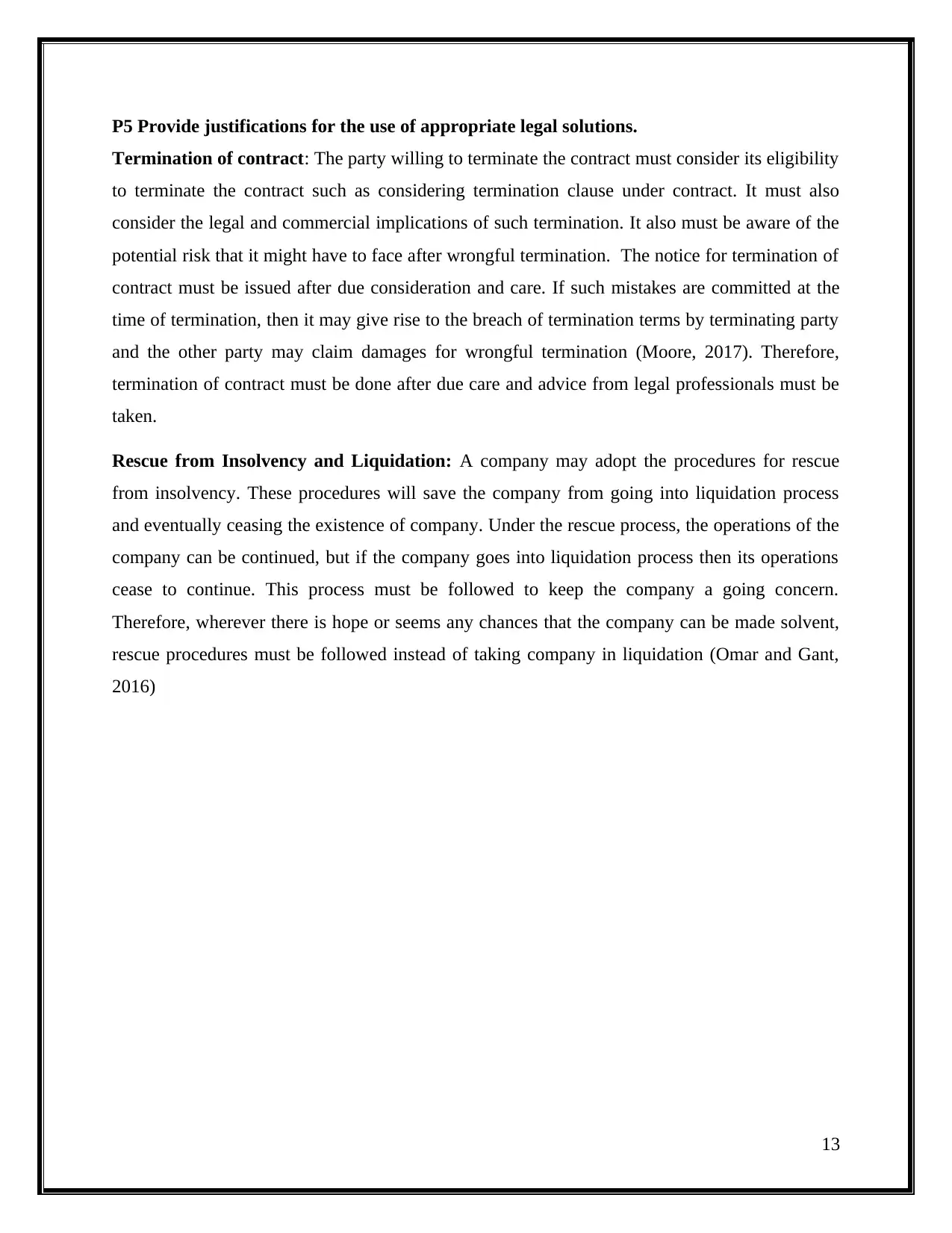
P5 Provide justifications for the use of appropriate legal solutions.
Termination of contract: The party willing to terminate the contract must consider its eligibility
to terminate the contract such as considering termination clause under contract. It must also
consider the legal and commercial implications of such termination. It also must be aware of the
potential risk that it might have to face after wrongful termination. The notice for termination of
contract must be issued after due consideration and care. If such mistakes are committed at the
time of termination, then it may give rise to the breach of termination terms by terminating party
and the other party may claim damages for wrongful termination (Moore, 2017). Therefore,
termination of contract must be done after due care and advice from legal professionals must be
taken.
Rescue from Insolvency and Liquidation: A company may adopt the procedures for rescue
from insolvency. These procedures will save the company from going into liquidation process
and eventually ceasing the existence of company. Under the rescue process, the operations of the
company can be continued, but if the company goes into liquidation process then its operations
cease to continue. This process must be followed to keep the company a going concern.
Therefore, wherever there is hope or seems any chances that the company can be made solvent,
rescue procedures must be followed instead of taking company in liquidation (Omar and Gant,
2016)
13
Termination of contract: The party willing to terminate the contract must consider its eligibility
to terminate the contract such as considering termination clause under contract. It must also
consider the legal and commercial implications of such termination. It also must be aware of the
potential risk that it might have to face after wrongful termination. The notice for termination of
contract must be issued after due consideration and care. If such mistakes are committed at the
time of termination, then it may give rise to the breach of termination terms by terminating party
and the other party may claim damages for wrongful termination (Moore, 2017). Therefore,
termination of contract must be done after due care and advice from legal professionals must be
taken.
Rescue from Insolvency and Liquidation: A company may adopt the procedures for rescue
from insolvency. These procedures will save the company from going into liquidation process
and eventually ceasing the existence of company. Under the rescue process, the operations of the
company can be continued, but if the company goes into liquidation process then its operations
cease to continue. This process must be followed to keep the company a going concern.
Therefore, wherever there is hope or seems any chances that the company can be made solvent,
rescue procedures must be followed instead of taking company in liquidation (Omar and Gant,
2016)
13
Paraphrase This Document
Need a fresh take? Get an instant paraphrase of this document with our AI Paraphraser
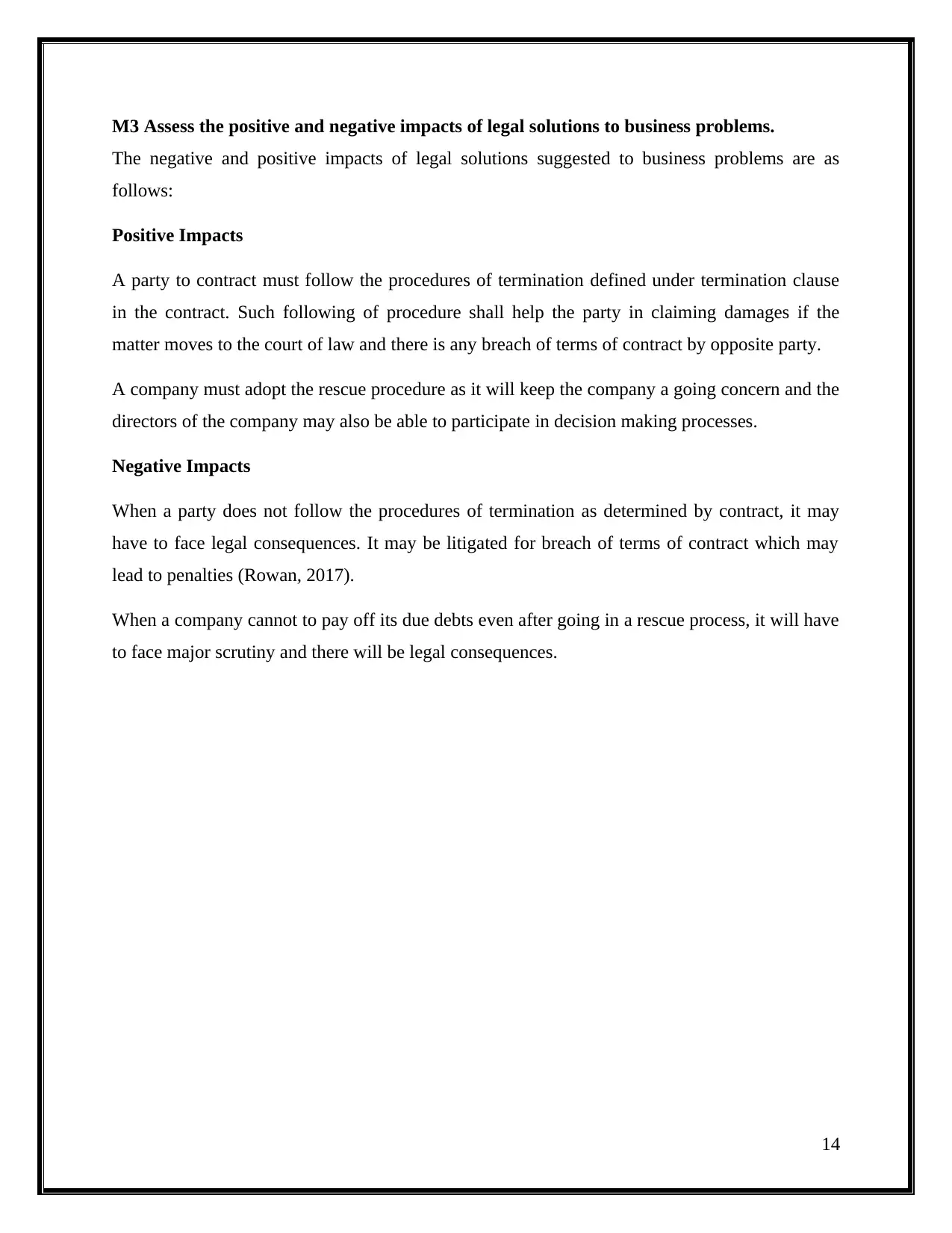
M3 Assess the positive and negative impacts of legal solutions to business problems.
The negative and positive impacts of legal solutions suggested to business problems are as
follows:
Positive Impacts
A party to contract must follow the procedures of termination defined under termination clause
in the contract. Such following of procedure shall help the party in claiming damages if the
matter moves to the court of law and there is any breach of terms of contract by opposite party.
A company must adopt the rescue procedure as it will keep the company a going concern and the
directors of the company may also be able to participate in decision making processes.
Negative Impacts
When a party does not follow the procedures of termination as determined by contract, it may
have to face legal consequences. It may be litigated for breach of terms of contract which may
lead to penalties (Rowan, 2017).
When a company cannot to pay off its due debts even after going in a rescue process, it will have
to face major scrutiny and there will be legal consequences.
14
The negative and positive impacts of legal solutions suggested to business problems are as
follows:
Positive Impacts
A party to contract must follow the procedures of termination defined under termination clause
in the contract. Such following of procedure shall help the party in claiming damages if the
matter moves to the court of law and there is any breach of terms of contract by opposite party.
A company must adopt the rescue procedure as it will keep the company a going concern and the
directors of the company may also be able to participate in decision making processes.
Negative Impacts
When a party does not follow the procedures of termination as determined by contract, it may
have to face legal consequences. It may be litigated for breach of terms of contract which may
lead to penalties (Rowan, 2017).
When a company cannot to pay off its due debts even after going in a rescue process, it will have
to face major scrutiny and there will be legal consequences.
14
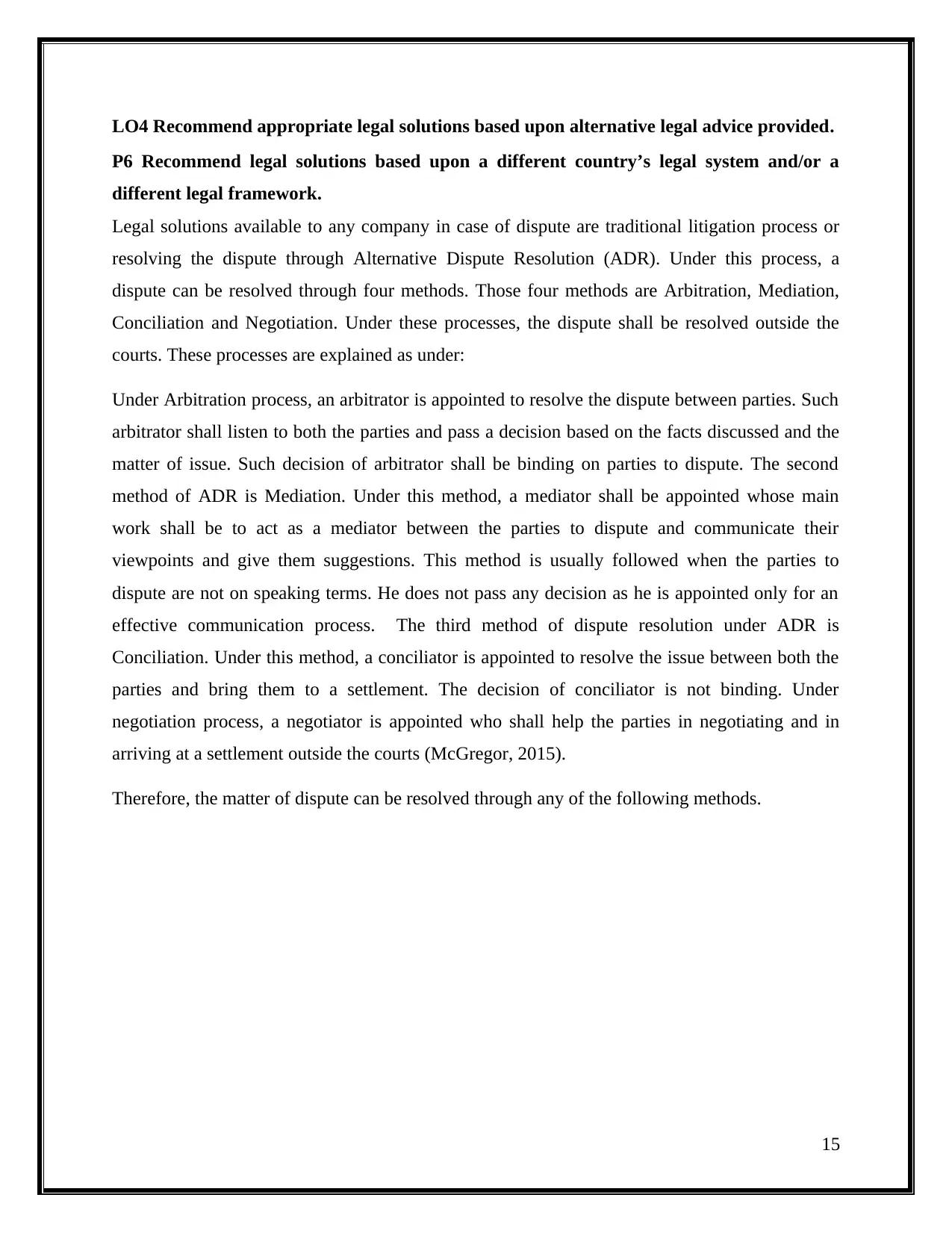
LO4 Recommend appropriate legal solutions based upon alternative legal advice provided.
P6 Recommend legal solutions based upon a different country’s legal system and/or a
different legal framework.
Legal solutions available to any company in case of dispute are traditional litigation process or
resolving the dispute through Alternative Dispute Resolution (ADR). Under this process, a
dispute can be resolved through four methods. Those four methods are Arbitration, Mediation,
Conciliation and Negotiation. Under these processes, the dispute shall be resolved outside the
courts. These processes are explained as under:
Under Arbitration process, an arbitrator is appointed to resolve the dispute between parties. Such
arbitrator shall listen to both the parties and pass a decision based on the facts discussed and the
matter of issue. Such decision of arbitrator shall be binding on parties to dispute. The second
method of ADR is Mediation. Under this method, a mediator shall be appointed whose main
work shall be to act as a mediator between the parties to dispute and communicate their
viewpoints and give them suggestions. This method is usually followed when the parties to
dispute are not on speaking terms. He does not pass any decision as he is appointed only for an
effective communication process. The third method of dispute resolution under ADR is
Conciliation. Under this method, a conciliator is appointed to resolve the issue between both the
parties and bring them to a settlement. The decision of conciliator is not binding. Under
negotiation process, a negotiator is appointed who shall help the parties in negotiating and in
arriving at a settlement outside the courts (McGregor, 2015).
Therefore, the matter of dispute can be resolved through any of the following methods.
15
P6 Recommend legal solutions based upon a different country’s legal system and/or a
different legal framework.
Legal solutions available to any company in case of dispute are traditional litigation process or
resolving the dispute through Alternative Dispute Resolution (ADR). Under this process, a
dispute can be resolved through four methods. Those four methods are Arbitration, Mediation,
Conciliation and Negotiation. Under these processes, the dispute shall be resolved outside the
courts. These processes are explained as under:
Under Arbitration process, an arbitrator is appointed to resolve the dispute between parties. Such
arbitrator shall listen to both the parties and pass a decision based on the facts discussed and the
matter of issue. Such decision of arbitrator shall be binding on parties to dispute. The second
method of ADR is Mediation. Under this method, a mediator shall be appointed whose main
work shall be to act as a mediator between the parties to dispute and communicate their
viewpoints and give them suggestions. This method is usually followed when the parties to
dispute are not on speaking terms. He does not pass any decision as he is appointed only for an
effective communication process. The third method of dispute resolution under ADR is
Conciliation. Under this method, a conciliator is appointed to resolve the issue between both the
parties and bring them to a settlement. The decision of conciliator is not binding. Under
negotiation process, a negotiator is appointed who shall help the parties in negotiating and in
arriving at a settlement outside the courts (McGregor, 2015).
Therefore, the matter of dispute can be resolved through any of the following methods.
15
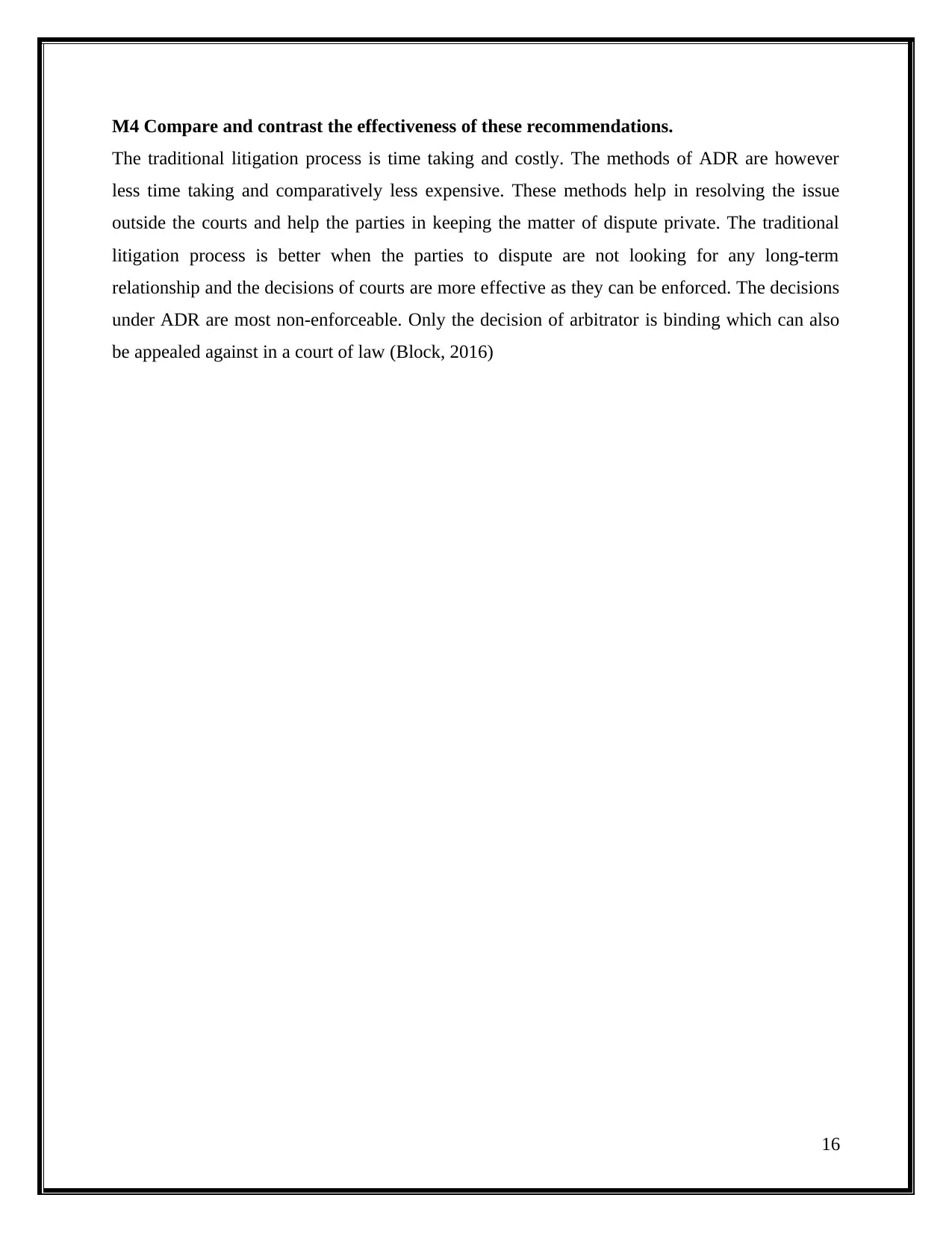
M4 Compare and contrast the effectiveness of these recommendations.
The traditional litigation process is time taking and costly. The methods of ADR are however
less time taking and comparatively less expensive. These methods help in resolving the issue
outside the courts and help the parties in keeping the matter of dispute private. The traditional
litigation process is better when the parties to dispute are not looking for any long-term
relationship and the decisions of courts are more effective as they can be enforced. The decisions
under ADR are most non-enforceable. Only the decision of arbitrator is binding which can also
be appealed against in a court of law (Block, 2016)
16
The traditional litigation process is time taking and costly. The methods of ADR are however
less time taking and comparatively less expensive. These methods help in resolving the issue
outside the courts and help the parties in keeping the matter of dispute private. The traditional
litigation process is better when the parties to dispute are not looking for any long-term
relationship and the decisions of courts are more effective as they can be enforced. The decisions
under ADR are most non-enforceable. Only the decision of arbitrator is binding which can also
be appealed against in a court of law (Block, 2016)
16
Secure Best Marks with AI Grader
Need help grading? Try our AI Grader for instant feedback on your assignments.
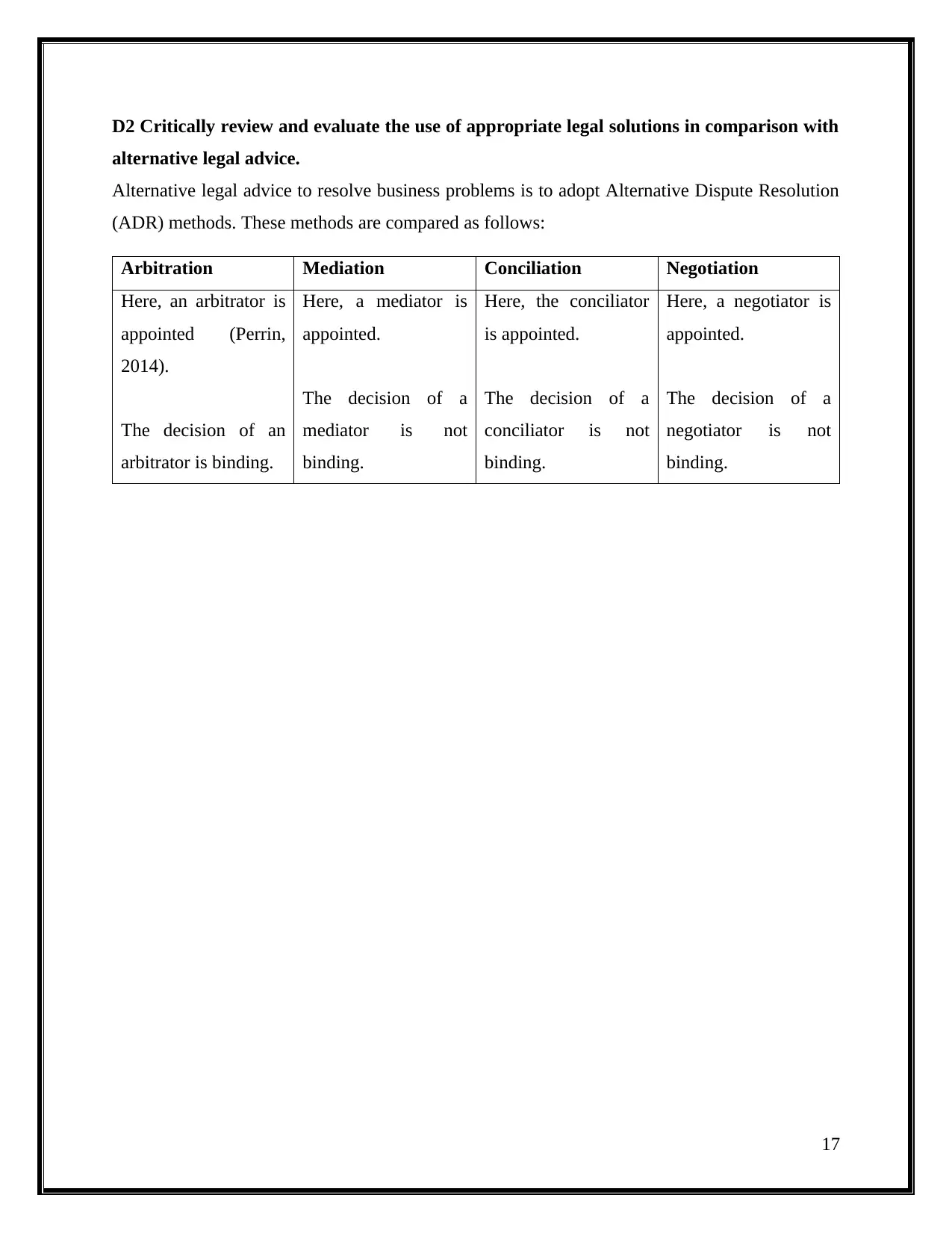
D2 Critically review and evaluate the use of appropriate legal solutions in comparison with
alternative legal advice.
Alternative legal advice to resolve business problems is to adopt Alternative Dispute Resolution
(ADR) methods. These methods are compared as follows:
Arbitration Mediation Conciliation Negotiation
Here, an arbitrator is
appointed (Perrin,
2014).
The decision of an
arbitrator is binding.
Here, a mediator is
appointed.
The decision of a
mediator is not
binding.
Here, the conciliator
is appointed.
The decision of a
conciliator is not
binding.
Here, a negotiator is
appointed.
The decision of a
negotiator is not
binding.
17
alternative legal advice.
Alternative legal advice to resolve business problems is to adopt Alternative Dispute Resolution
(ADR) methods. These methods are compared as follows:
Arbitration Mediation Conciliation Negotiation
Here, an arbitrator is
appointed (Perrin,
2014).
The decision of an
arbitrator is binding.
Here, a mediator is
appointed.
The decision of a
mediator is not
binding.
Here, the conciliator
is appointed.
The decision of a
conciliator is not
binding.
Here, a negotiator is
appointed.
The decision of a
negotiator is not
binding.
17
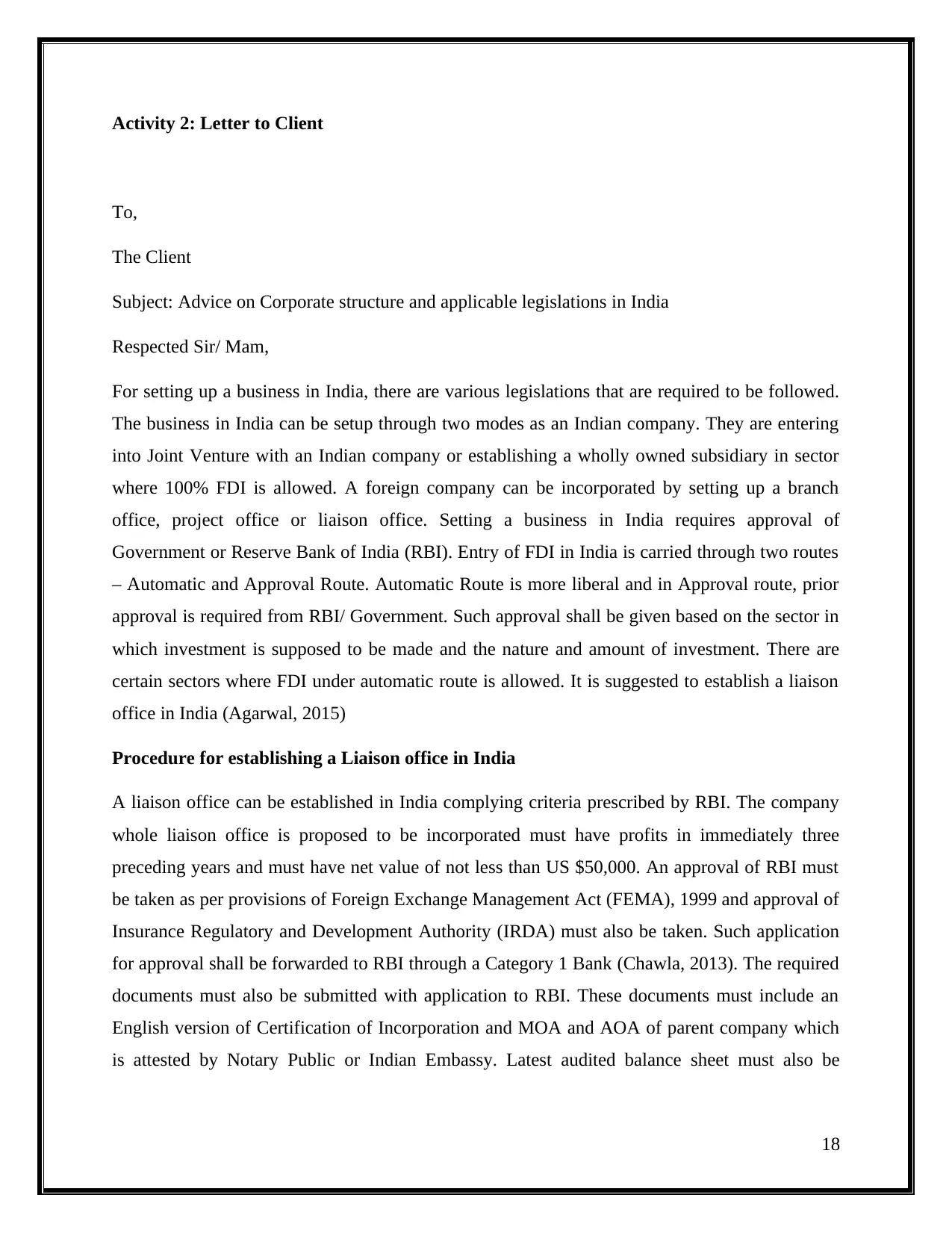
Activity 2: Letter to Client
To,
The Client
Subject: Advice on Corporate structure and applicable legislations in India
Respected Sir/ Mam,
For setting up a business in India, there are various legislations that are required to be followed.
The business in India can be setup through two modes as an Indian company. They are entering
into Joint Venture with an Indian company or establishing a wholly owned subsidiary in sector
where 100% FDI is allowed. A foreign company can be incorporated by setting up a branch
office, project office or liaison office. Setting a business in India requires approval of
Government or Reserve Bank of India (RBI). Entry of FDI in India is carried through two routes
– Automatic and Approval Route. Automatic Route is more liberal and in Approval route, prior
approval is required from RBI/ Government. Such approval shall be given based on the sector in
which investment is supposed to be made and the nature and amount of investment. There are
certain sectors where FDI under automatic route is allowed. It is suggested to establish a liaison
office in India (Agarwal, 2015)
Procedure for establishing a Liaison office in India
A liaison office can be established in India complying criteria prescribed by RBI. The company
whole liaison office is proposed to be incorporated must have profits in immediately three
preceding years and must have net value of not less than US $50,000. An approval of RBI must
be taken as per provisions of Foreign Exchange Management Act (FEMA), 1999 and approval of
Insurance Regulatory and Development Authority (IRDA) must also be taken. Such application
for approval shall be forwarded to RBI through a Category 1 Bank (Chawla, 2013). The required
documents must also be submitted with application to RBI. These documents must include an
English version of Certification of Incorporation and MOA and AOA of parent company which
is attested by Notary Public or Indian Embassy. Latest audited balance sheet must also be
18
To,
The Client
Subject: Advice on Corporate structure and applicable legislations in India
Respected Sir/ Mam,
For setting up a business in India, there are various legislations that are required to be followed.
The business in India can be setup through two modes as an Indian company. They are entering
into Joint Venture with an Indian company or establishing a wholly owned subsidiary in sector
where 100% FDI is allowed. A foreign company can be incorporated by setting up a branch
office, project office or liaison office. Setting a business in India requires approval of
Government or Reserve Bank of India (RBI). Entry of FDI in India is carried through two routes
– Automatic and Approval Route. Automatic Route is more liberal and in Approval route, prior
approval is required from RBI/ Government. Such approval shall be given based on the sector in
which investment is supposed to be made and the nature and amount of investment. There are
certain sectors where FDI under automatic route is allowed. It is suggested to establish a liaison
office in India (Agarwal, 2015)
Procedure for establishing a Liaison office in India
A liaison office can be established in India complying criteria prescribed by RBI. The company
whole liaison office is proposed to be incorporated must have profits in immediately three
preceding years and must have net value of not less than US $50,000. An approval of RBI must
be taken as per provisions of Foreign Exchange Management Act (FEMA), 1999 and approval of
Insurance Regulatory and Development Authority (IRDA) must also be taken. Such application
for approval shall be forwarded to RBI through a Category 1 Bank (Chawla, 2013). The required
documents must also be submitted with application to RBI. These documents must include an
English version of Certification of Incorporation and MOA and AOA of parent company which
is attested by Notary Public or Indian Embassy. Latest audited balance sheet must also be
18
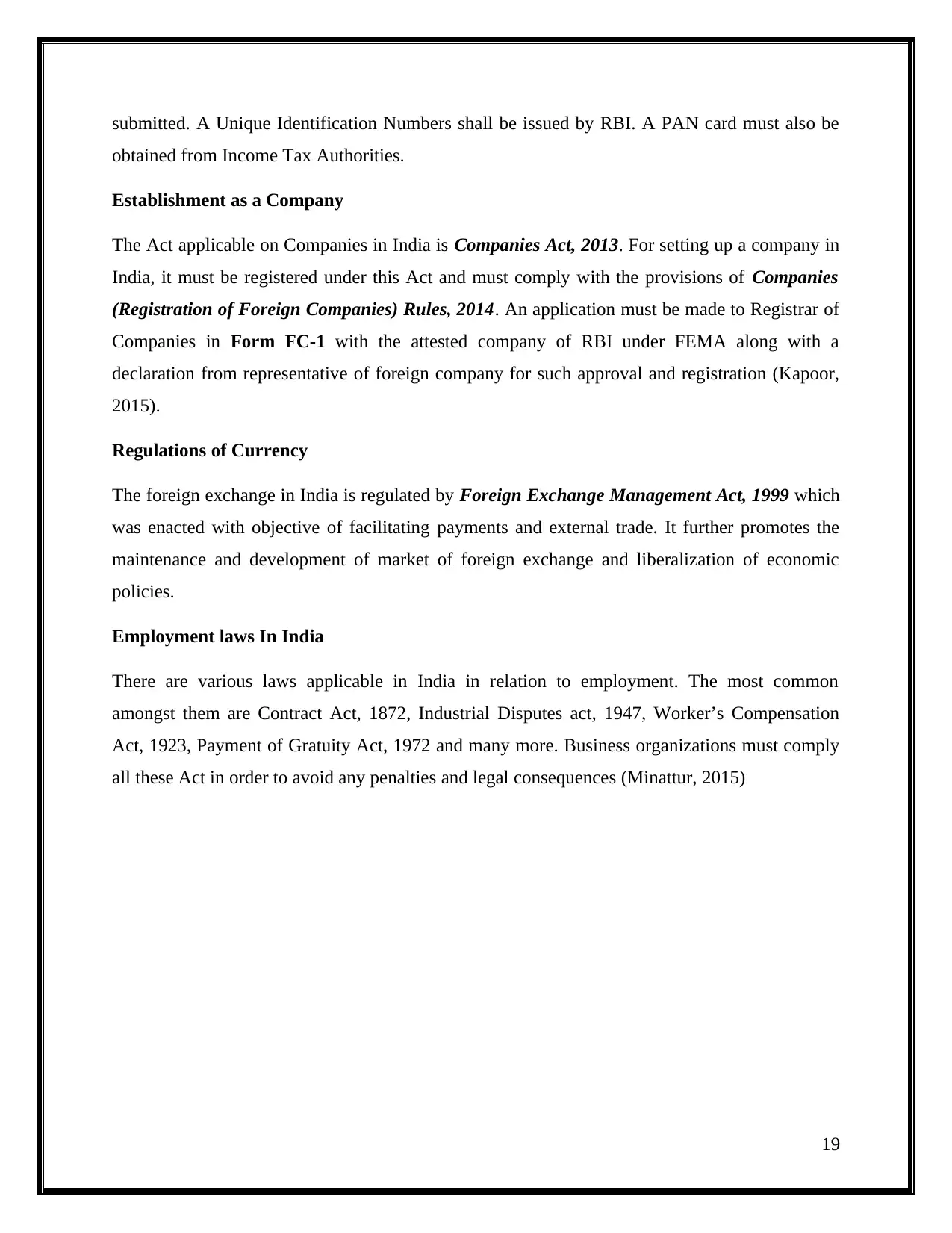
submitted. A Unique Identification Numbers shall be issued by RBI. A PAN card must also be
obtained from Income Tax Authorities.
Establishment as a Company
The Act applicable on Companies in India is Companies Act, 2013. For setting up a company in
India, it must be registered under this Act and must comply with the provisions of Companies
(Registration of Foreign Companies) Rules, 2014. An application must be made to Registrar of
Companies in Form FC-1 with the attested company of RBI under FEMA along with a
declaration from representative of foreign company for such approval and registration (Kapoor,
2015).
Regulations of Currency
The foreign exchange in India is regulated by Foreign Exchange Management Act, 1999 which
was enacted with objective of facilitating payments and external trade. It further promotes the
maintenance and development of market of foreign exchange and liberalization of economic
policies.
Employment laws In India
There are various laws applicable in India in relation to employment. The most common
amongst them are Contract Act, 1872, Industrial Disputes act, 1947, Worker’s Compensation
Act, 1923, Payment of Gratuity Act, 1972 and many more. Business organizations must comply
all these Act in order to avoid any penalties and legal consequences (Minattur, 2015)
19
obtained from Income Tax Authorities.
Establishment as a Company
The Act applicable on Companies in India is Companies Act, 2013. For setting up a company in
India, it must be registered under this Act and must comply with the provisions of Companies
(Registration of Foreign Companies) Rules, 2014. An application must be made to Registrar of
Companies in Form FC-1 with the attested company of RBI under FEMA along with a
declaration from representative of foreign company for such approval and registration (Kapoor,
2015).
Regulations of Currency
The foreign exchange in India is regulated by Foreign Exchange Management Act, 1999 which
was enacted with objective of facilitating payments and external trade. It further promotes the
maintenance and development of market of foreign exchange and liberalization of economic
policies.
Employment laws In India
There are various laws applicable in India in relation to employment. The most common
amongst them are Contract Act, 1872, Industrial Disputes act, 1947, Worker’s Compensation
Act, 1923, Payment of Gratuity Act, 1972 and many more. Business organizations must comply
all these Act in order to avoid any penalties and legal consequences (Minattur, 2015)
19
Paraphrase This Document
Need a fresh take? Get an instant paraphrase of this document with our AI Paraphraser
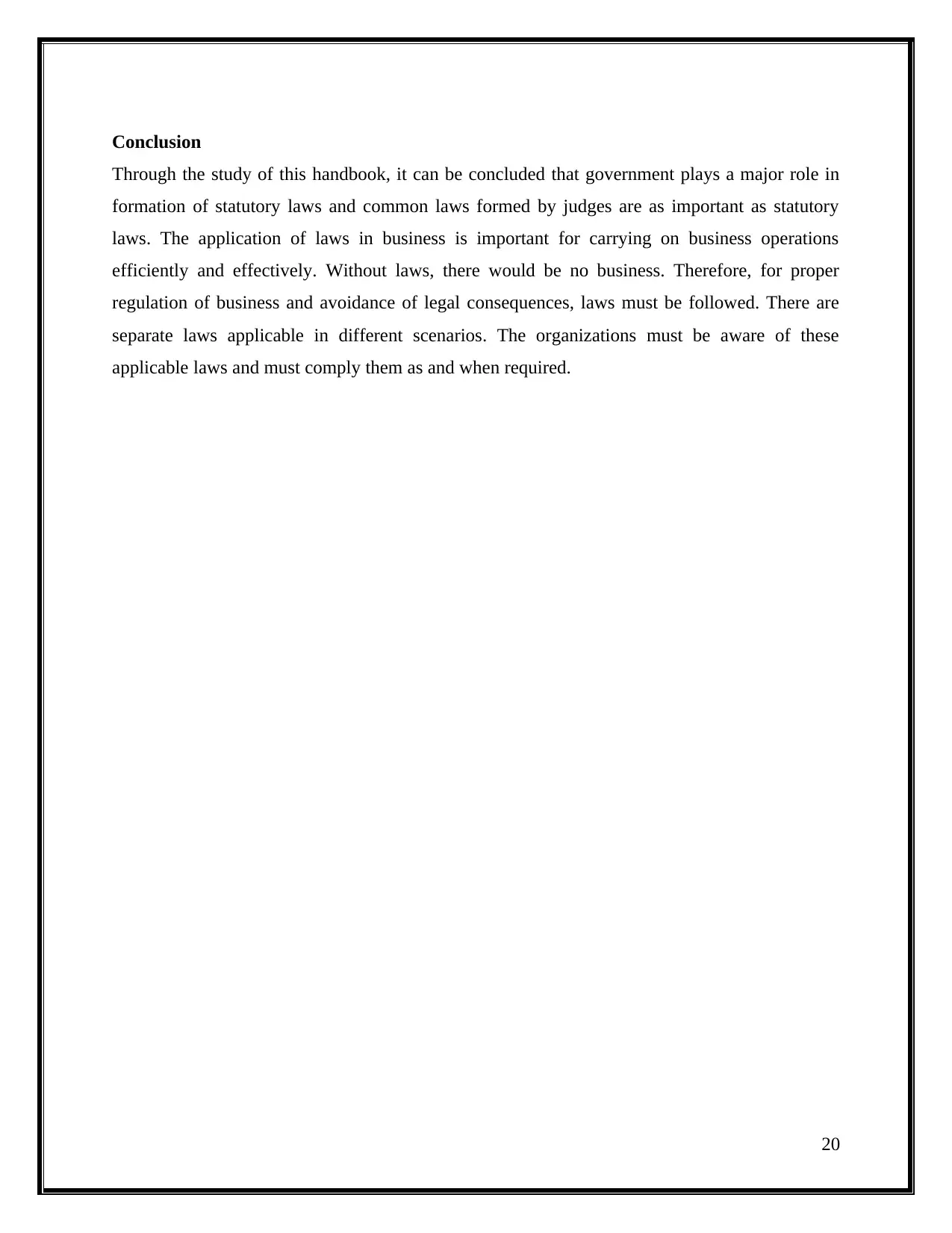
Conclusion
Through the study of this handbook, it can be concluded that government plays a major role in
formation of statutory laws and common laws formed by judges are as important as statutory
laws. The application of laws in business is important for carrying on business operations
efficiently and effectively. Without laws, there would be no business. Therefore, for proper
regulation of business and avoidance of legal consequences, laws must be followed. There are
separate laws applicable in different scenarios. The organizations must be aware of these
applicable laws and must comply them as and when required.
20
Through the study of this handbook, it can be concluded that government plays a major role in
formation of statutory laws and common laws formed by judges are as important as statutory
laws. The application of laws in business is important for carrying on business operations
efficiently and effectively. Without laws, there would be no business. Therefore, for proper
regulation of business and avoidance of legal consequences, laws must be followed. There are
separate laws applicable in different scenarios. The organizations must be aware of these
applicable laws and must comply them as and when required.
20
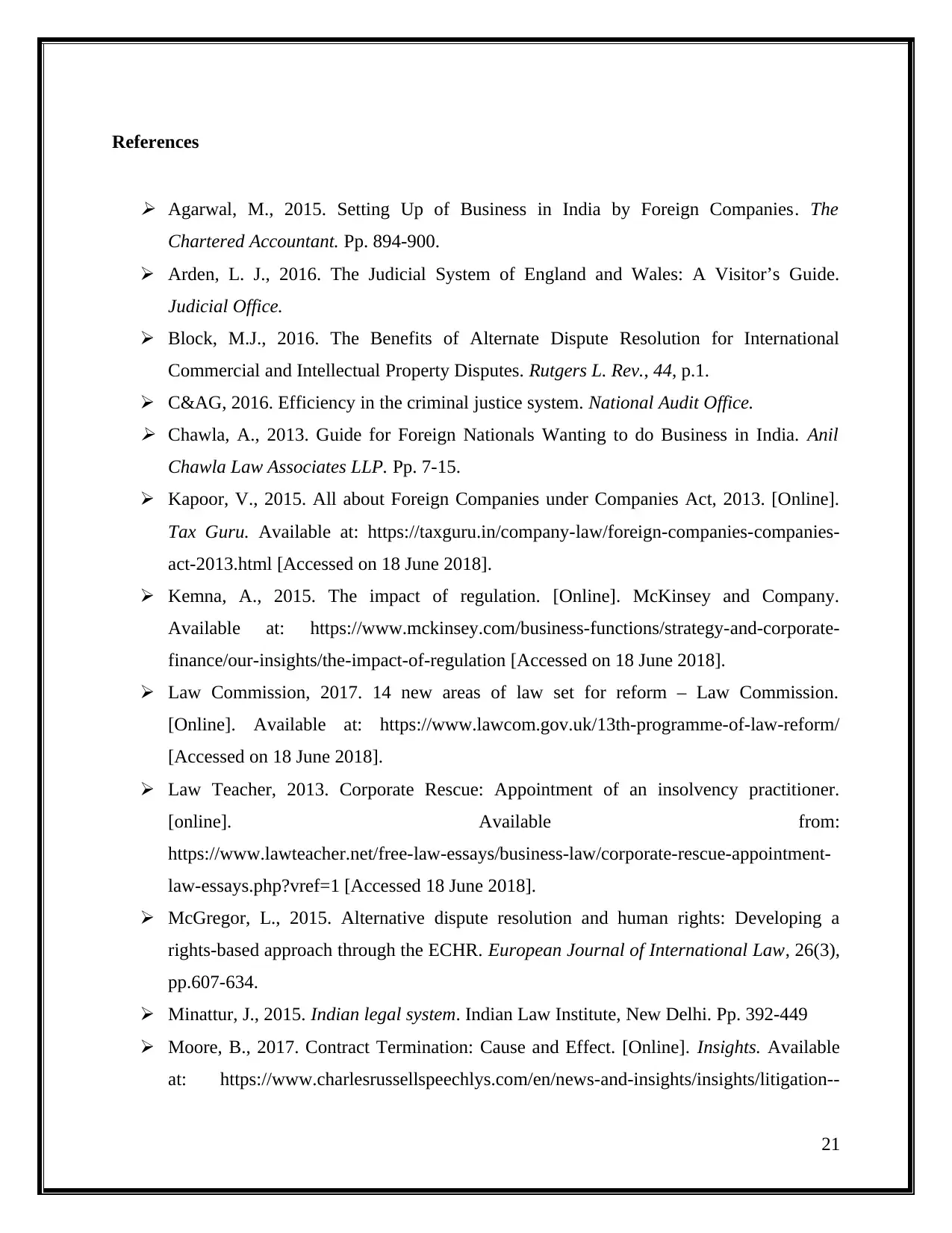
References
Agarwal, M., 2015. Setting Up of Business in India by Foreign Companies. The
Chartered Accountant. Pp. 894-900.
Arden, L. J., 2016. The Judicial System of England and Wales: A Visitor’s Guide.
Judicial Office.
Block, M.J., 2016. The Benefits of Alternate Dispute Resolution for International
Commercial and Intellectual Property Disputes. Rutgers L. Rev., 44, p.1.
C&AG, 2016. Efficiency in the criminal justice system. National Audit Office. Chawla, A., 2013. Guide for Foreign Nationals Wanting to do Business in India. Anil
Chawla Law Associates LLP. Pp. 7-15.
Kapoor, V., 2015. All about Foreign Companies under Companies Act, 2013. [Online].
Tax Guru. Available at: https://taxguru.in/company-law/foreign-companies-companies-
act-2013.html [Accessed on 18 June 2018].
Kemna, A., 2015. The impact of regulation. [Online]. McKinsey and Company.
Available at: https://www.mckinsey.com/business-functions/strategy-and-corporate-
finance/our-insights/the-impact-of-regulation [Accessed on 18 June 2018].
Law Commission, 2017. 14 new areas of law set for reform – Law Commission.
[Online]. Available at: https://www.lawcom.gov.uk/13th-programme-of-law-reform/
[Accessed on 18 June 2018].
Law Teacher, 2013. Corporate Rescue: Appointment of an insolvency practitioner.
[online]. Available from:
https://www.lawteacher.net/free-law-essays/business-law/corporate-rescue-appointment-
law-essays.php?vref=1 [Accessed 18 June 2018].
McGregor, L., 2015. Alternative dispute resolution and human rights: Developing a
rights-based approach through the ECHR. European Journal of International Law, 26(3),
pp.607-634.
Minattur, J., 2015. Indian legal system. Indian Law Institute, New Delhi. Pp. 392-449
Moore, B., 2017. Contract Termination: Cause and Effect. [Online]. Insights. Available
at: https://www.charlesrussellspeechlys.com/en/news-and-insights/insights/litigation--
21
Agarwal, M., 2015. Setting Up of Business in India by Foreign Companies. The
Chartered Accountant. Pp. 894-900.
Arden, L. J., 2016. The Judicial System of England and Wales: A Visitor’s Guide.
Judicial Office.
Block, M.J., 2016. The Benefits of Alternate Dispute Resolution for International
Commercial and Intellectual Property Disputes. Rutgers L. Rev., 44, p.1.
C&AG, 2016. Efficiency in the criminal justice system. National Audit Office. Chawla, A., 2013. Guide for Foreign Nationals Wanting to do Business in India. Anil
Chawla Law Associates LLP. Pp. 7-15.
Kapoor, V., 2015. All about Foreign Companies under Companies Act, 2013. [Online].
Tax Guru. Available at: https://taxguru.in/company-law/foreign-companies-companies-
act-2013.html [Accessed on 18 June 2018].
Kemna, A., 2015. The impact of regulation. [Online]. McKinsey and Company.
Available at: https://www.mckinsey.com/business-functions/strategy-and-corporate-
finance/our-insights/the-impact-of-regulation [Accessed on 18 June 2018].
Law Commission, 2017. 14 new areas of law set for reform – Law Commission.
[Online]. Available at: https://www.lawcom.gov.uk/13th-programme-of-law-reform/
[Accessed on 18 June 2018].
Law Teacher, 2013. Corporate Rescue: Appointment of an insolvency practitioner.
[online]. Available from:
https://www.lawteacher.net/free-law-essays/business-law/corporate-rescue-appointment-
law-essays.php?vref=1 [Accessed 18 June 2018].
McGregor, L., 2015. Alternative dispute resolution and human rights: Developing a
rights-based approach through the ECHR. European Journal of International Law, 26(3),
pp.607-634.
Minattur, J., 2015. Indian legal system. Indian Law Institute, New Delhi. Pp. 392-449
Moore, B., 2017. Contract Termination: Cause and Effect. [Online]. Insights. Available
at: https://www.charlesrussellspeechlys.com/en/news-and-insights/insights/litigation--
21
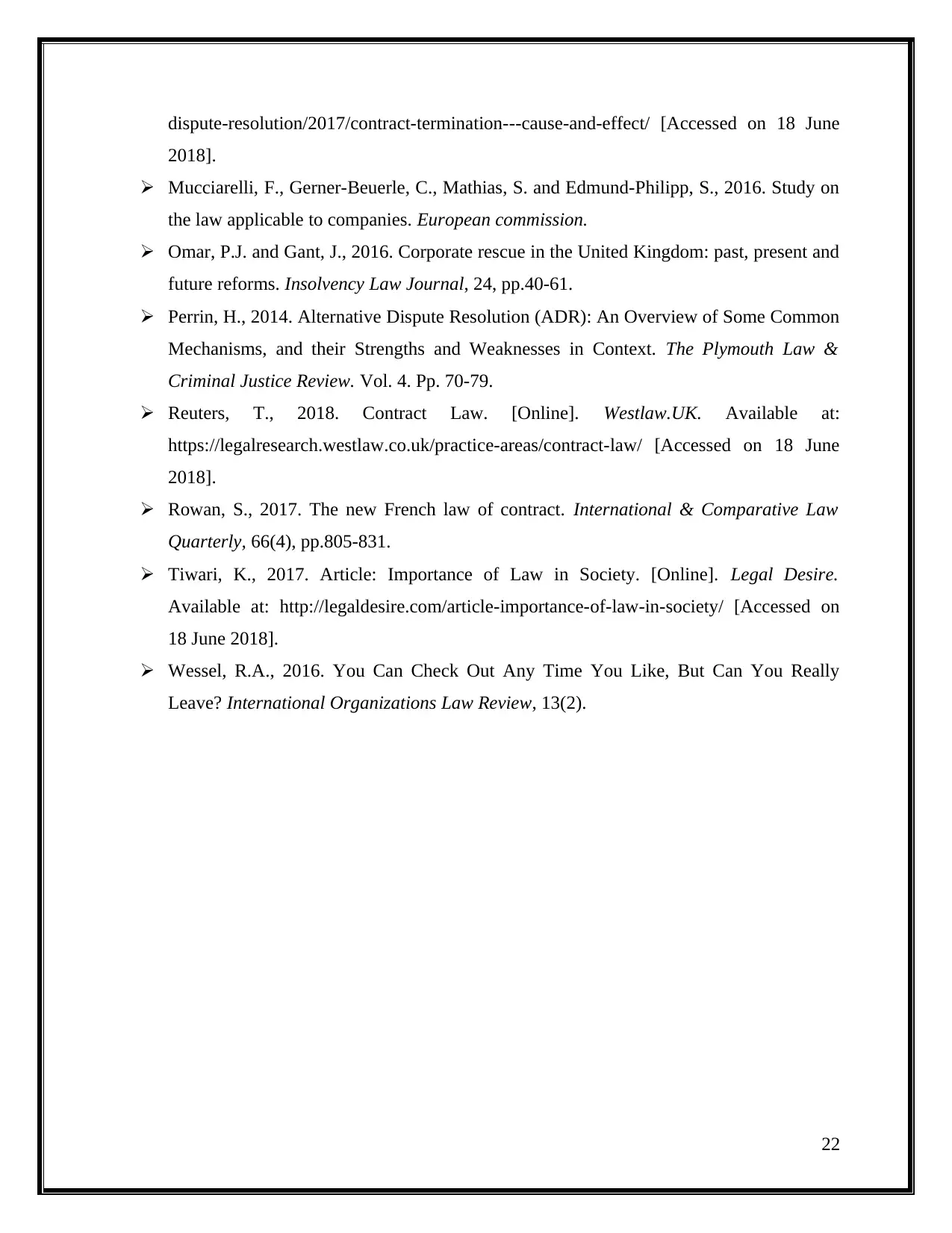
dispute-resolution/2017/contract-termination---cause-and-effect/ [Accessed on 18 June
2018].
Mucciarelli, F., Gerner-Beuerle, C., Mathias, S. and Edmund-Philipp, S., 2016. Study on
the law applicable to companies. European commission.
Omar, P.J. and Gant, J., 2016. Corporate rescue in the United Kingdom: past, present and
future reforms. Insolvency Law Journal, 24, pp.40-61.
Perrin, H., 2014. Alternative Dispute Resolution (ADR): An Overview of Some Common
Mechanisms, and their Strengths and Weaknesses in Context. The Plymouth Law &
Criminal Justice Review. Vol. 4. Pp. 70-79.
Reuters, T., 2018. Contract Law. [Online]. Westlaw.UK. Available at:
https://legalresearch.westlaw.co.uk/practice-areas/contract-law/ [Accessed on 18 June
2018].
Rowan, S., 2017. The new French law of contract. International & Comparative Law
Quarterly, 66(4), pp.805-831.
Tiwari, K., 2017. Article: Importance of Law in Society. [Online]. Legal Desire.
Available at: http://legaldesire.com/article-importance-of-law-in-society/ [Accessed on
18 June 2018].
Wessel, R.A., 2016. You Can Check Out Any Time You Like, But Can You Really
Leave? International Organizations Law Review, 13(2).
22
2018].
Mucciarelli, F., Gerner-Beuerle, C., Mathias, S. and Edmund-Philipp, S., 2016. Study on
the law applicable to companies. European commission.
Omar, P.J. and Gant, J., 2016. Corporate rescue in the United Kingdom: past, present and
future reforms. Insolvency Law Journal, 24, pp.40-61.
Perrin, H., 2014. Alternative Dispute Resolution (ADR): An Overview of Some Common
Mechanisms, and their Strengths and Weaknesses in Context. The Plymouth Law &
Criminal Justice Review. Vol. 4. Pp. 70-79.
Reuters, T., 2018. Contract Law. [Online]. Westlaw.UK. Available at:
https://legalresearch.westlaw.co.uk/practice-areas/contract-law/ [Accessed on 18 June
2018].
Rowan, S., 2017. The new French law of contract. International & Comparative Law
Quarterly, 66(4), pp.805-831.
Tiwari, K., 2017. Article: Importance of Law in Society. [Online]. Legal Desire.
Available at: http://legaldesire.com/article-importance-of-law-in-society/ [Accessed on
18 June 2018].
Wessel, R.A., 2016. You Can Check Out Any Time You Like, But Can You Really
Leave? International Organizations Law Review, 13(2).
22
1 out of 22
Related Documents
Your All-in-One AI-Powered Toolkit for Academic Success.
+13062052269
info@desklib.com
Available 24*7 on WhatsApp / Email
![[object Object]](/_next/static/media/star-bottom.7253800d.svg)
Unlock your academic potential
© 2024 | Zucol Services PVT LTD | All rights reserved.





